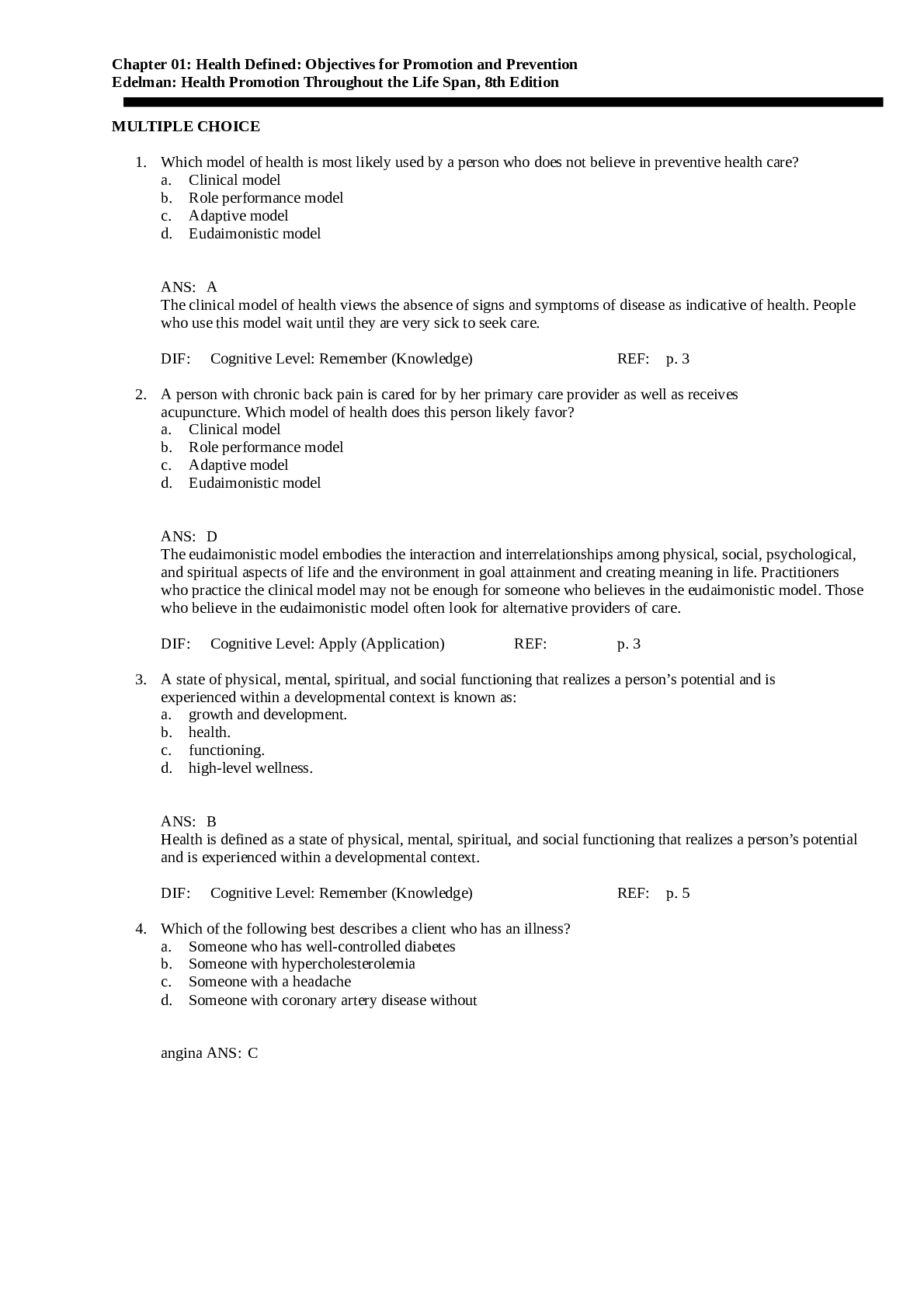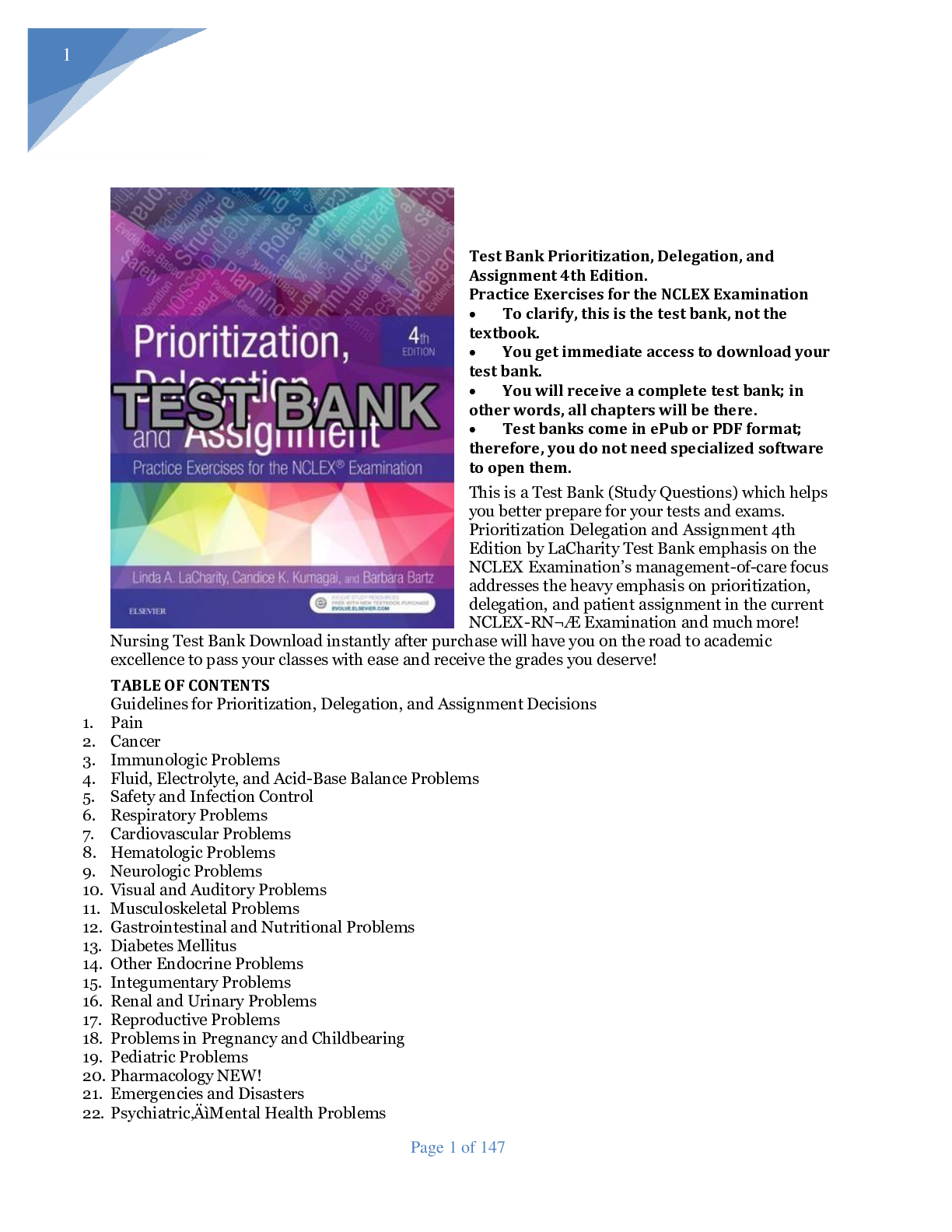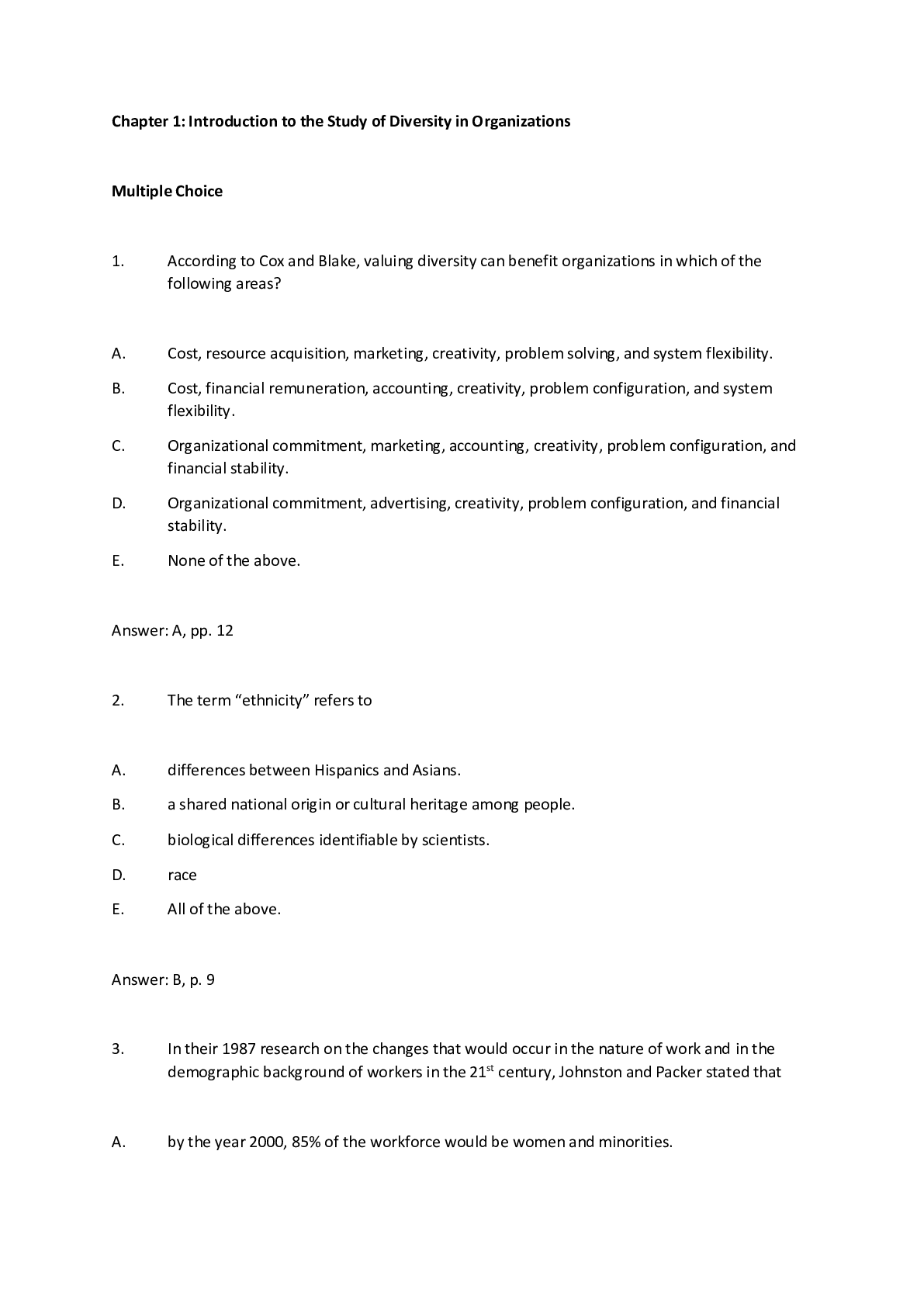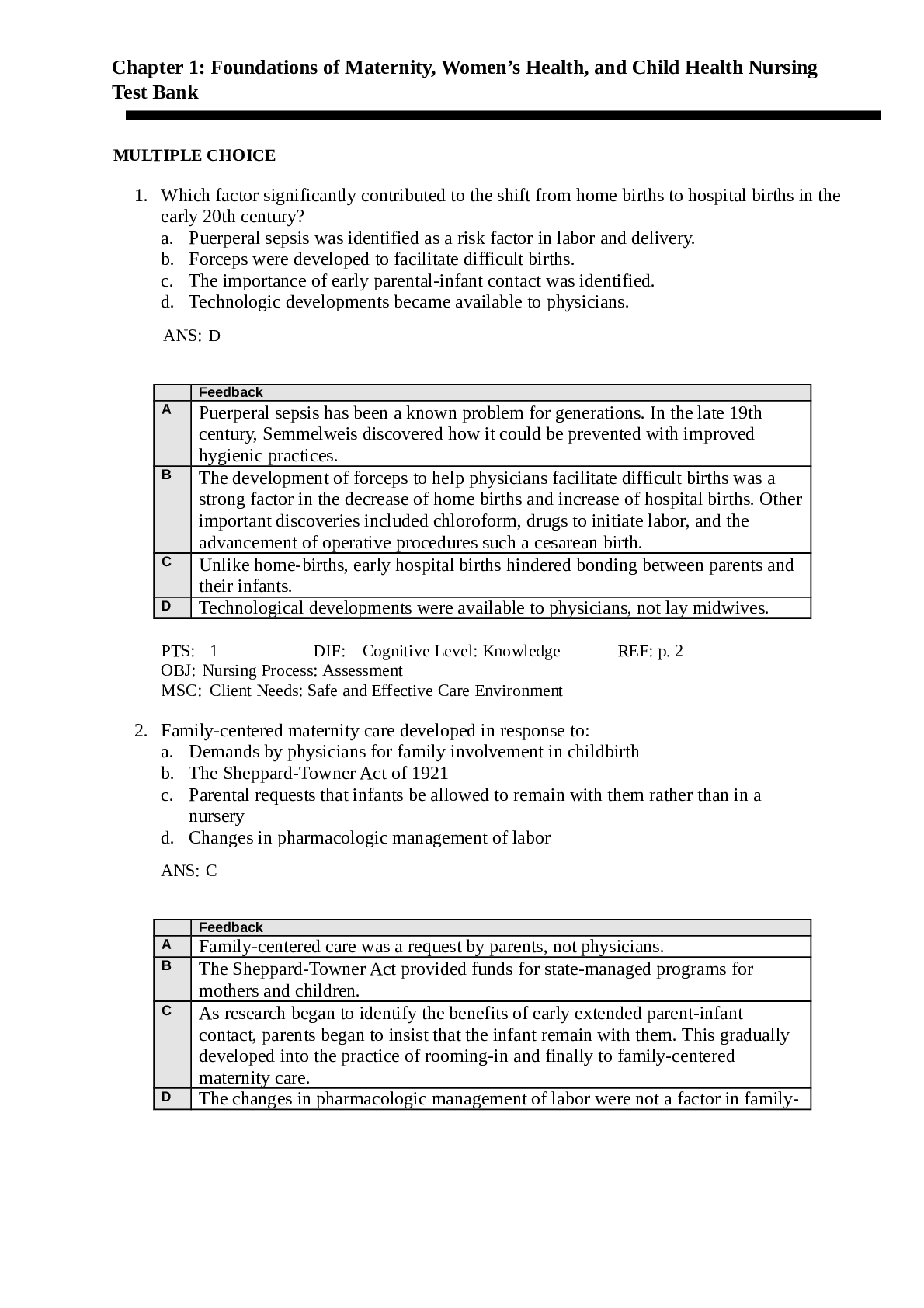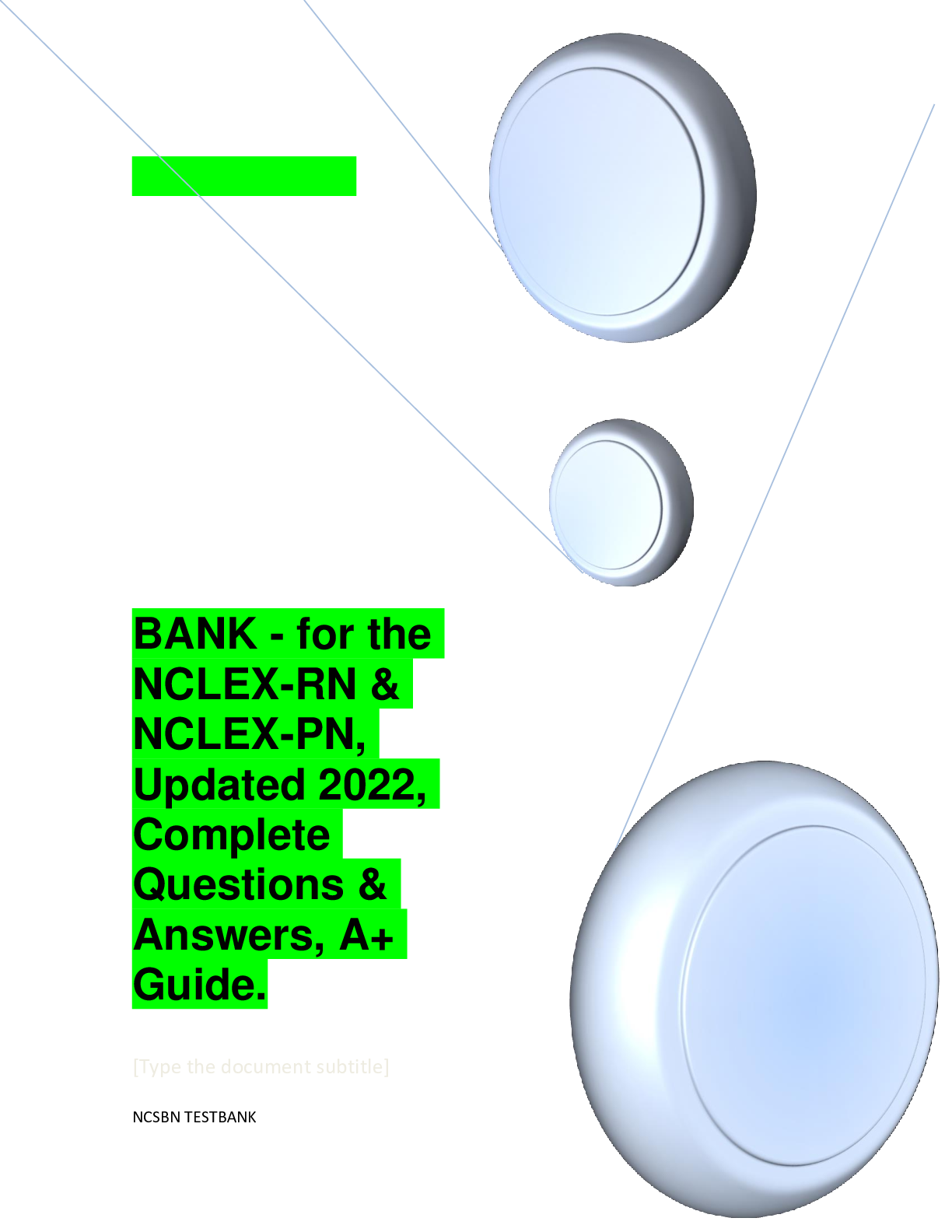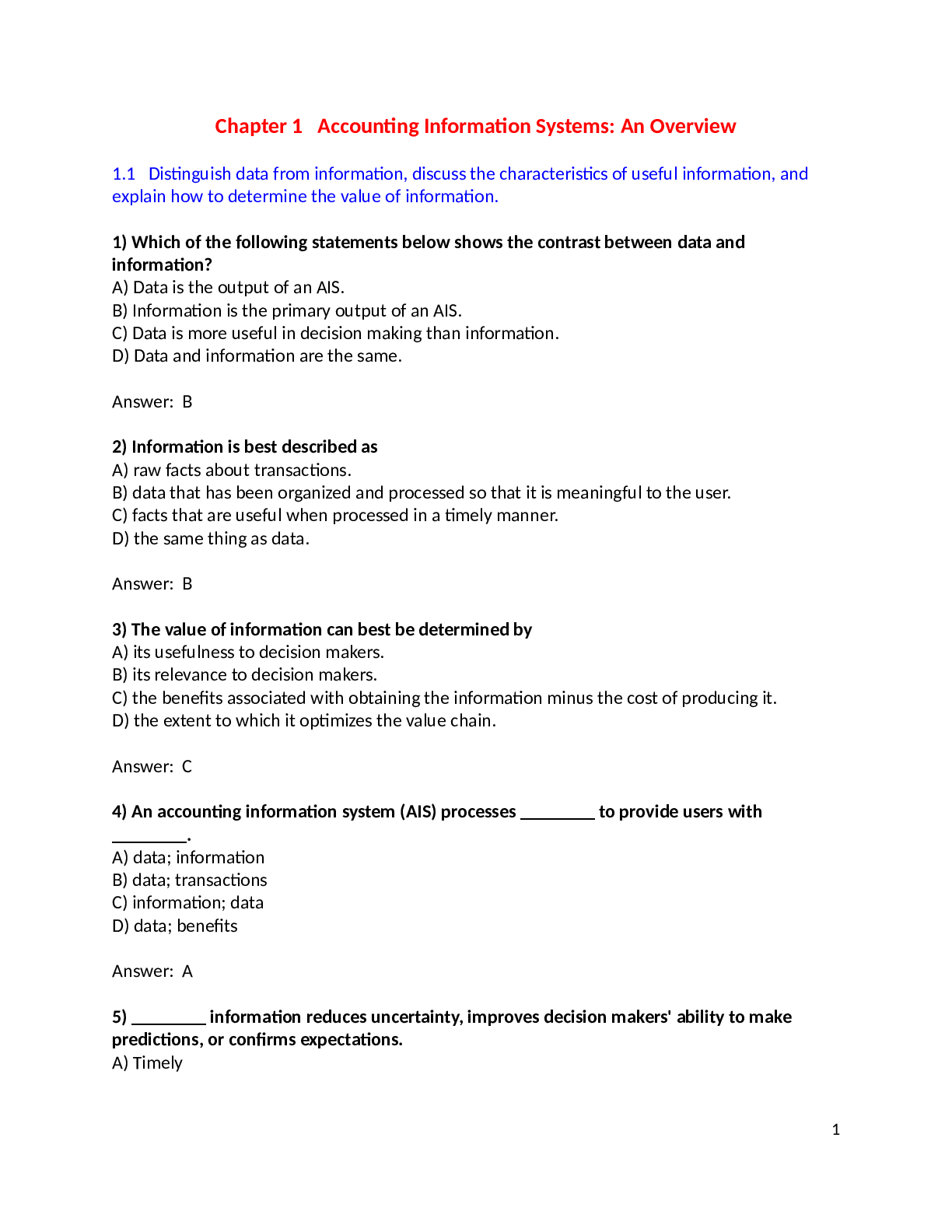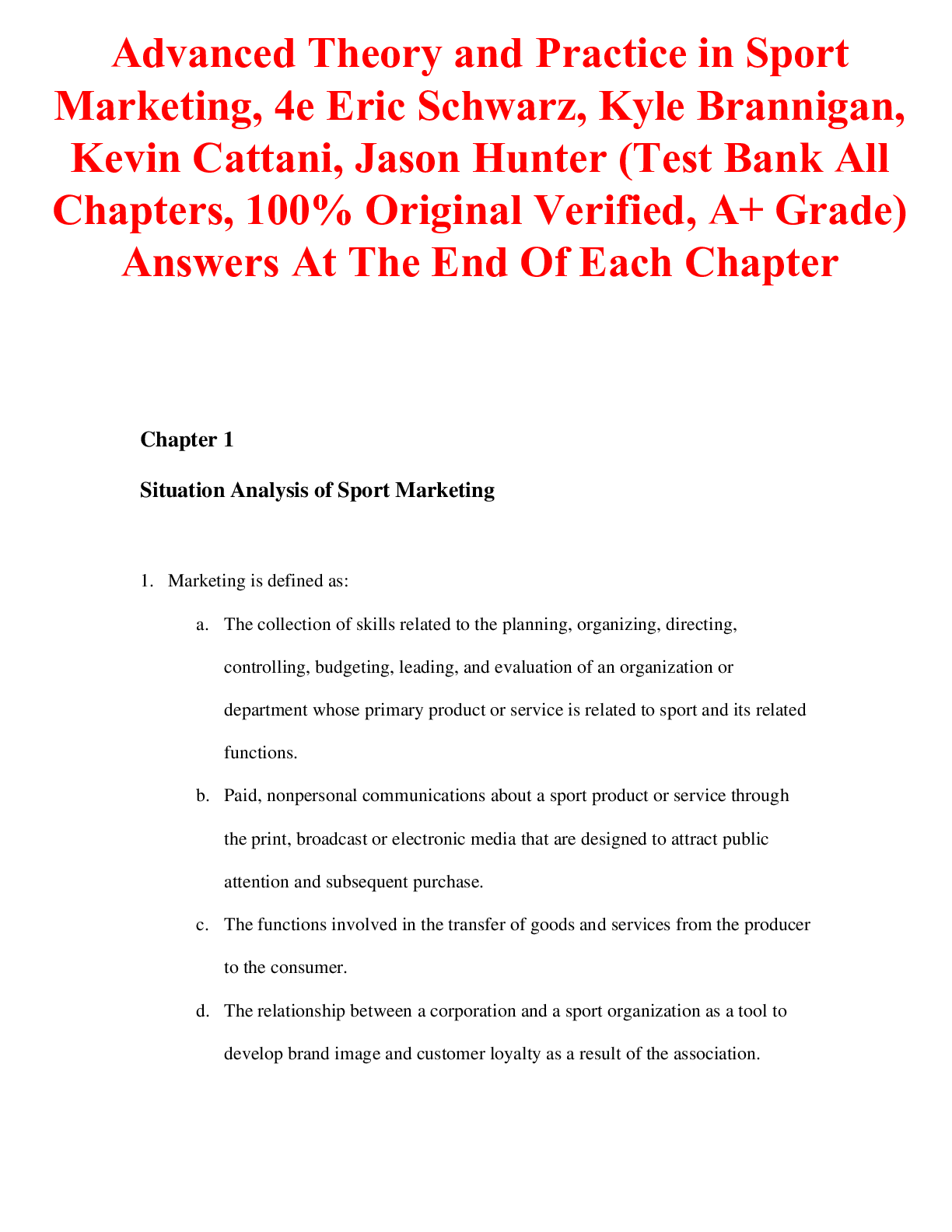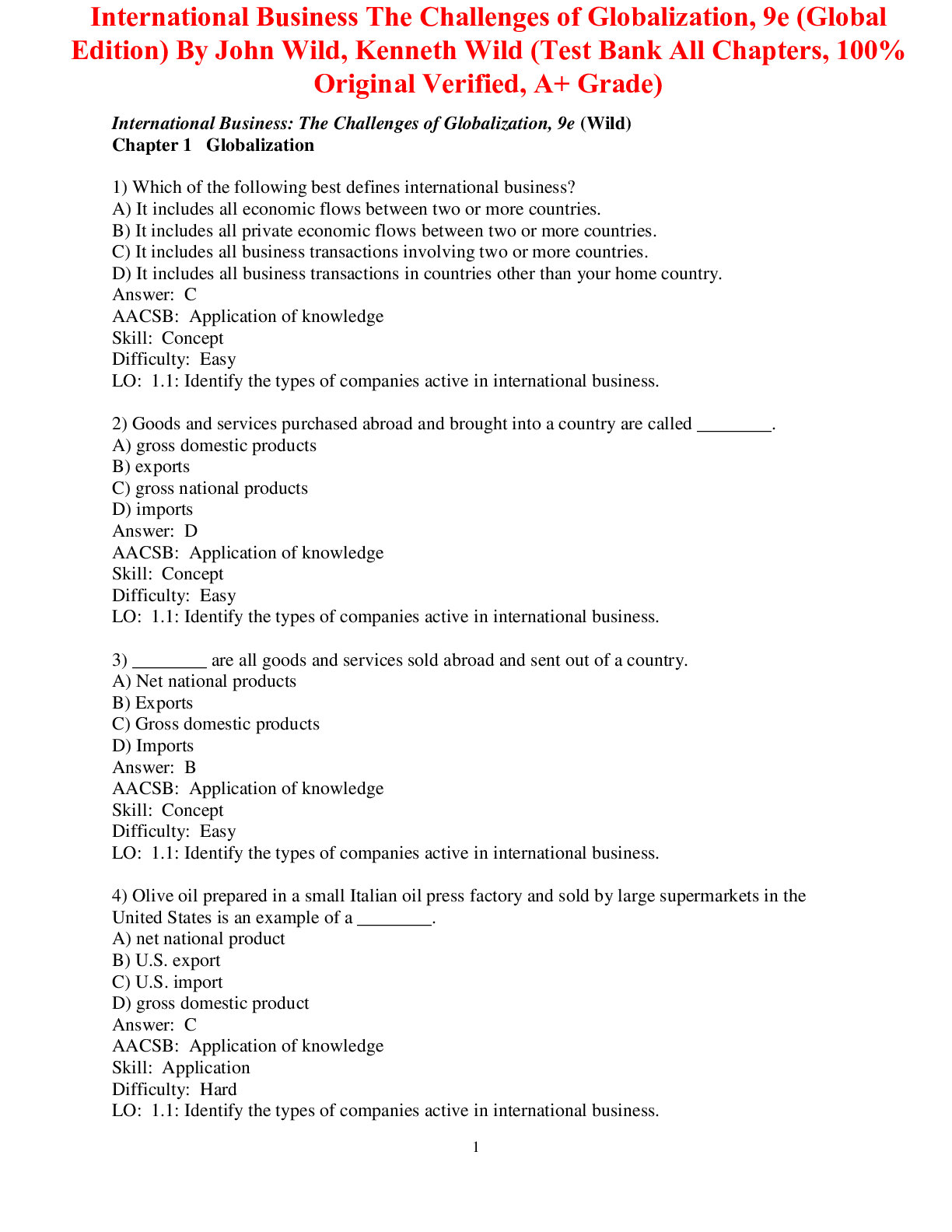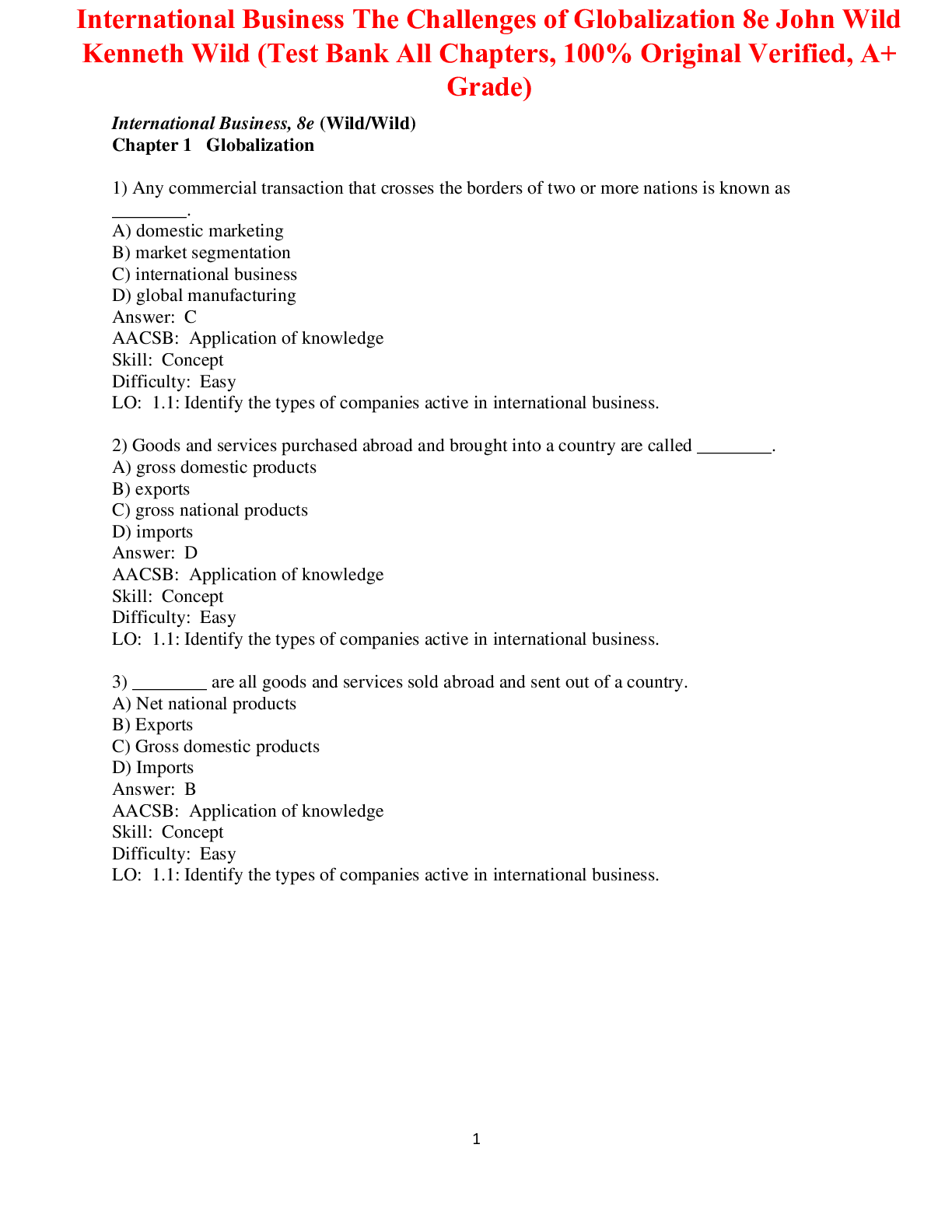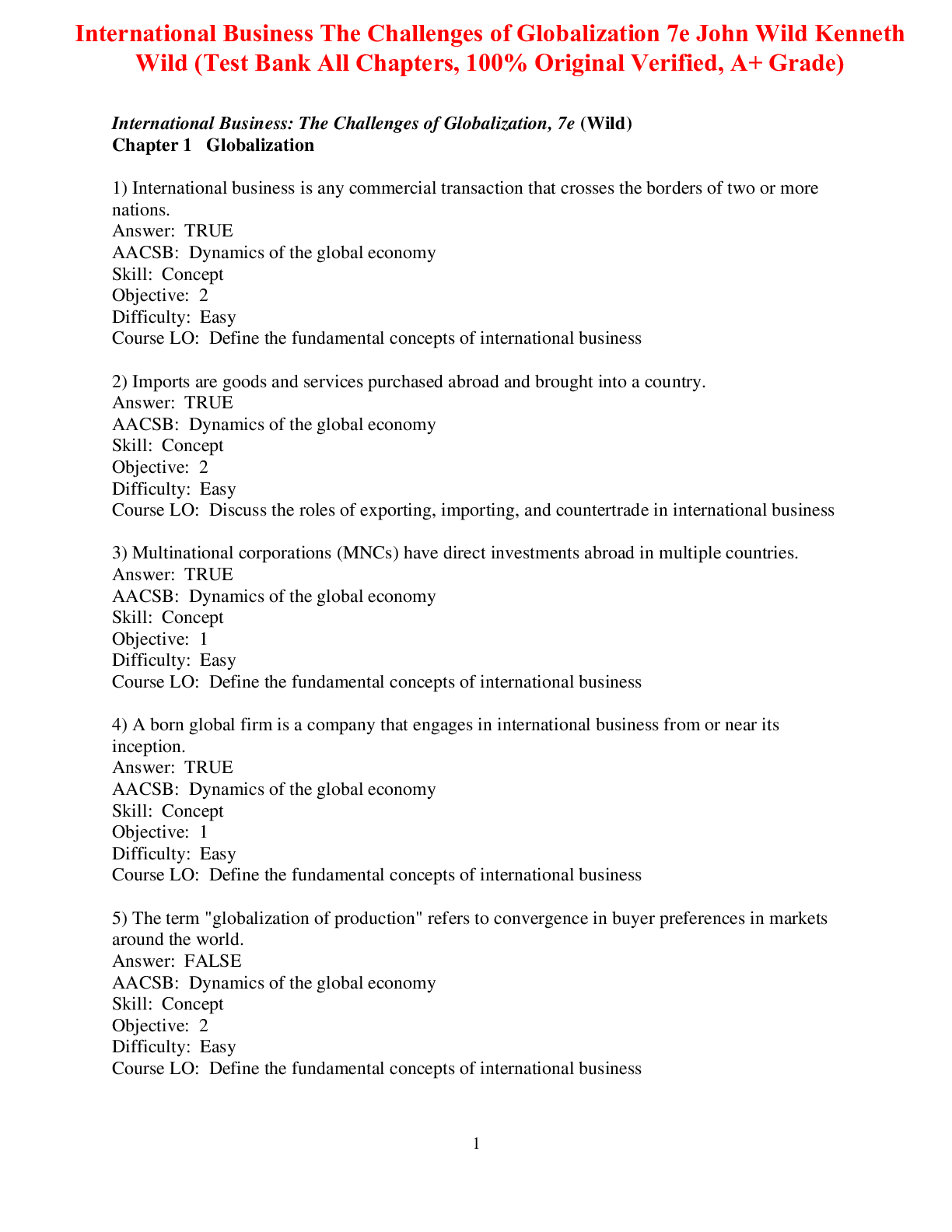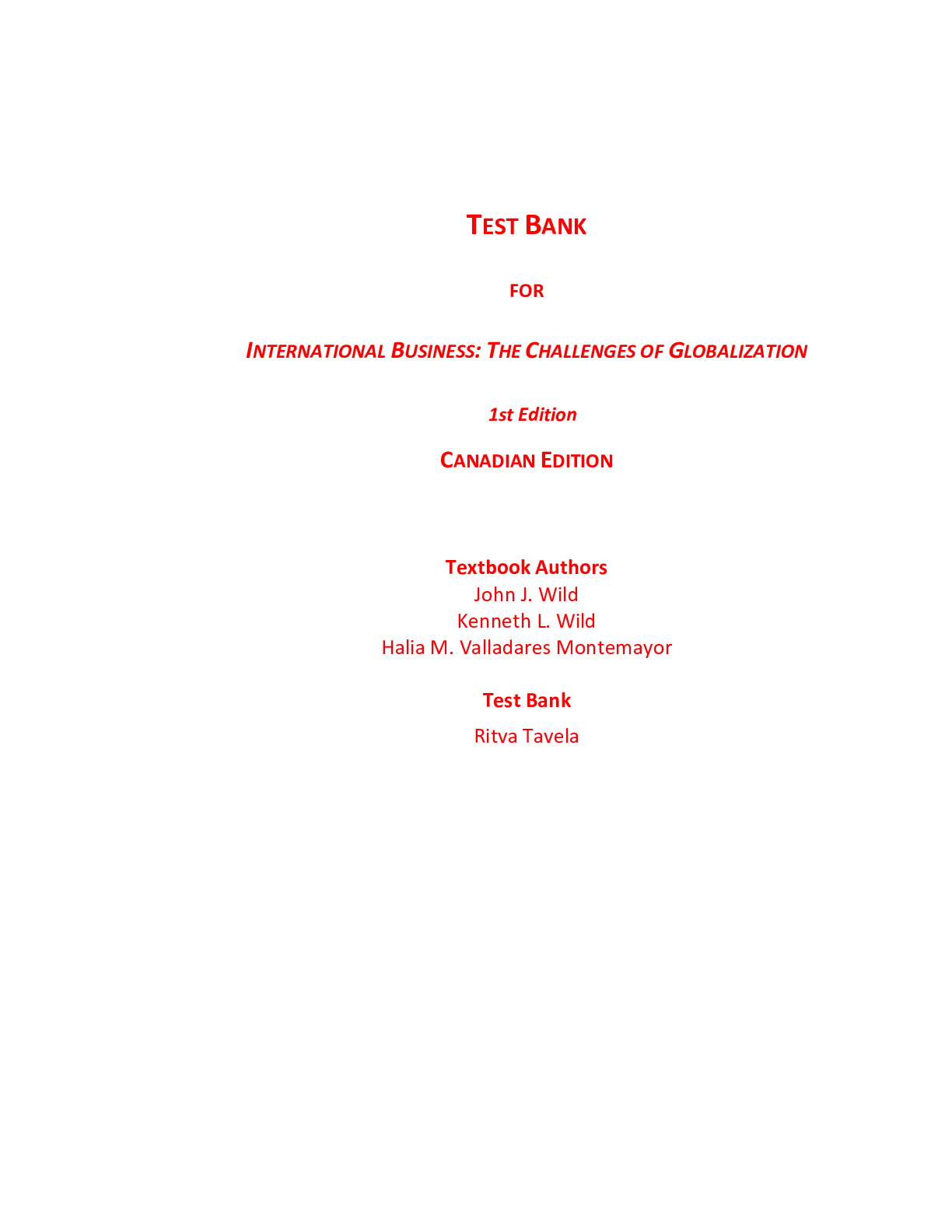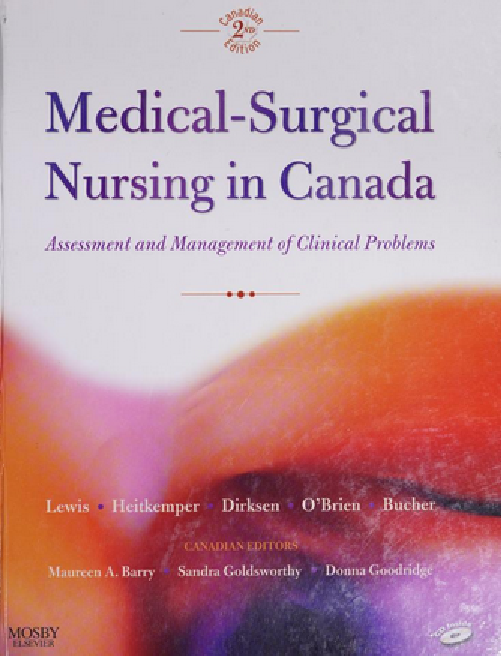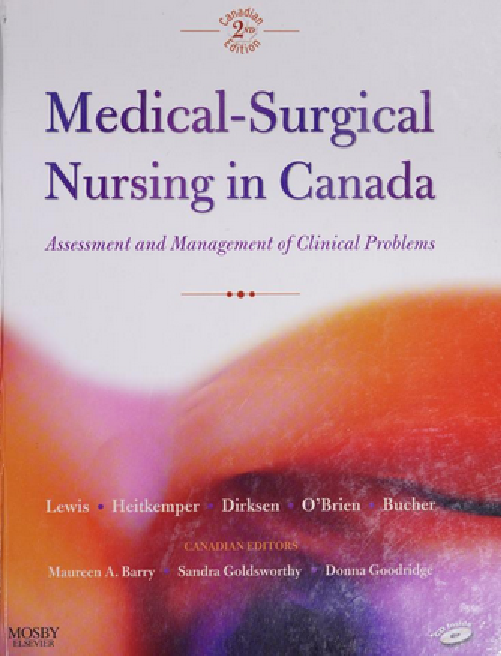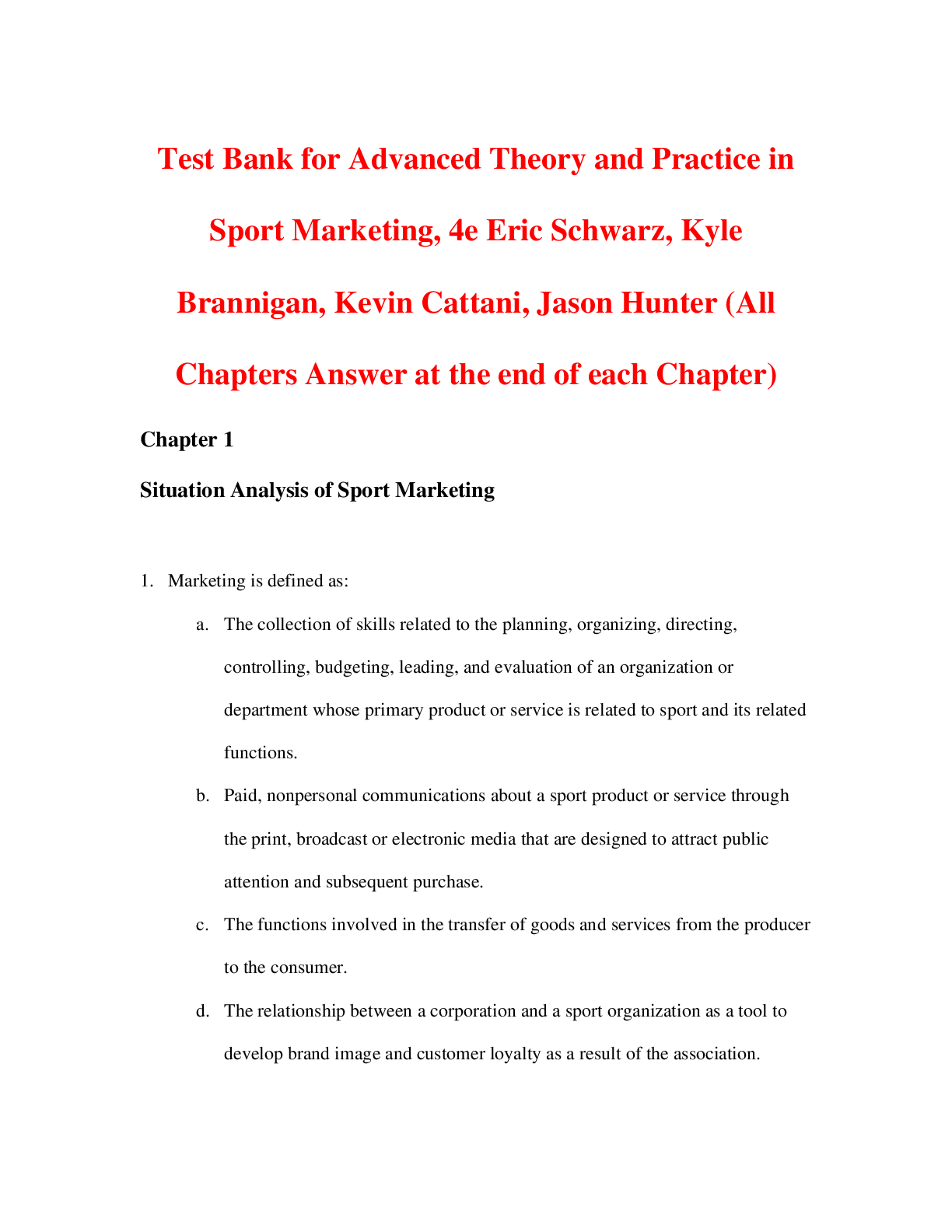NR 222 - Final Exam Testbank Questions & Answers, A+ Guide
Document Content and Description Below
NR 222 - Final Exam Testbank LEADERSHIP #3 A nurse enters the room of a client and finds the client lying on the floor. Which of the following actions should the nurse take first? A. Inspect the cl... ient for injuries An RN on a medical-surgical unit is making assignments at the beginning of the shift. Which of the following tasks should the nurse delegate to the PN? A. Obtain vital signs for a client who is 2 hr post procedure following a cardiac catheterization A PN ending their shift reports to the RN that a newly hired AP has not calculated the intake and output for several clients. Which of the following actions should the RN take? A. Ask the AP if they need assistance A nurse manager is developing an orientation plan for newly licensed nurses. Which of the following information should the manager include in the plan? Select all that apply. A. Skill proficiency B. Assignment to a preceptor C. Computerized charting D. Socialization into unit culture E. Facility policies and procedures A nurse manager is providing information about the audit process to members of the nursing team. Which of the following information should the nurse manager include? Select all that apply. A. A structure audit evaluates the setting and resources available to provide care B. An outcome audit evaluates the results of the nursing care provided C. A root cause analysis is indicated when a sentinel event occurs D. After data collection is completed, it is compared to a benchmark A nurse is participating in a quality improvement study of a procedure frequently performed on the unit. Which of the following information will provide data regarding the efficacy of the procedure? A. Incidence of complications related to procedure A nurse is hired to replace a staff member who has resigned. After working on the unit for several weeks, the nurse notices that the unit manager does not intervene when there is conflict between team members, even when it escalates. Which of the following conflict resolution strategies is the unit manager demonstrating? A. Avoidance A nurse is preparing a transfer a client who is 72 hr postoperative to a long-term facility. Which of the following information should the nurse include in the transfer report? Select all that apply. A. Advanced directives status B. Medical diagnosis C. Need for specific equipment A nurse is assisting with the discharge planning for a client. Which of the following actions should the nurse take? A. Determine the client’s need for home medical equipment B. Obtain printed instructions for medication self-administration C. Provide the family with a list of community agencies that can provide assistance D. Discuss the importance of attending follow-up appointments. A case manager is discussing critical pathways with a group of newly hired nurses. Which of the following statements indicates understanding? A. “The pathway shows an estimate of the number of days the client will be hospitalized.” A nurse who has just assumed the role of unit manager is examining the skills necessary for interprofessional collaboration. Which of the following actions support the nurse’s interprofessional collaboration? Select all that apply. A. Recognize the knowledge and skills of each member of the team B. Encourage the client and the family to participate in the team meeting C. Support team member requests for referral A nurse is caring for a client who has chest pain. The client says, “I am going home immediately.” Which of the following actions should the nurse take? Select all that apply. A. Document the client’s intent to leave the facility against medical advice B. Explain to the client the risks involved if they choose to leave C. Ask the client to sign a form relinquishing responsibility of the facility A nurse is discussing the disaster planning with the board members of a hospital. Which of the following individuals should the nurse expect to request extra supplies and staffing for the facility. A. Medical command physician DISASTER PREPAREDNESS#1 EMERGENCY NURSING #4 1. An emergency room nurse assesses a client who has been raped. With which health care team member should the nurse collaborate when planning this clients care? c. Forensic nurse 2. The emergency department team is performing cardiopulmonary resuscitation on a client when the clients spouse arrives at the emergency department. Which action should the nurse take first? b. Ask the spouse if he wishes to be present during the resuscitation. 3. An emergency room nurse is triaging victims of a multi-casualty event. Which client should receive care first? c. A 26-year-old male who has pale, cool, clammy skin 4. While triaging clients in a crowded emergency department, a nurse assesses a client who presents with symptoms of tuberculosis. Which action should the nurse take first? c. Transfer the client to a negative-pressure room. 5. A nurse is triaging clients in the emergency department (ED). Which client should the nurse prioritize to receive care first? b. A 45-year-old reporting chest pain and diaphoresis 6. A nurse is evaluating levels and functions of trauma centers. Which function is appropriately paired with the level of the trauma center? b. Level II Located within community hospitals and provides care to most injured clients 7. Emergency medical technicians arrive at the emergency department with an unresponsive client who has an oxygen mask in place. Which action should the nurse take first? a. Assess that the client is breathing adequately. 8. A trauma client with multiple open wounds is brought to the emergency department in cardiac arrest. Which action should the nurse take prior to providing advanced cardiac life support? b. Don personal protective equipment. 9. A nurse is triaging clients in the emergency department. Which client should be considered urgent? a. c. A 75-year-old female with a cough and a temperature of 102 F 10. An emergency department nurse is caring for a client who has died from a suspected homicide. Which action should the nurse take? d. Communicate the clients death to the family in a simple and concrete manner. 11. An emergency department (ED) case manager is consulted for a client who is homeless. Which intervention should the case manager provide? c. Provide referrals to subsidized community-based health clinics. 12. An emergency department nurse is caring for a client who is homeless. Which action should the nurse take to gain the clients trust? c. Listen to the clients concerns and needs. 13. A nurse is triaging clients in the emergency department. Which client should the nurse classify as nonurgent? c. A 62-year-old with a simple fracture of the left arm 1. A nurse is caring for clients in a busy emergency department. Which actions should the nurse take to ensure client and staff safety? (Select all that apply.) b. Use two identifiers before each intervention and before mediation administration. c. Attempt de-escalation strategies for clients who demonstrate aggressive behaviors. d. Search the belongings of clients with altered mental status to gain essential medical information. 2. An emergency department (ED) nurse is preparing to transfer a client to the trauma intensive care unit. Which information should the nurse include in the nurse-to-nurse hand-off report? (Select all that apply.) a. Mechanism of injury b. Diagnostic test results e. Isolation precautions 3. An emergency room nurse is caring for a trauma client. Which interventions should the nurse perform during the primary survey? (Select all that apply.) b. Needle decompression c. Initiating IV fluids e. Endotracheal intubation f. Removing wet clothing 4. The complex care provided during an emergency requires interdisciplinary collaboration. Which interdisciplinary team members are paired with the correct responsibilities? (Select all that apply.) a. Psychiatric crisis nurse Interacts with clients and families when sudden illness, serious injury, or death of a loved one may cause a crisis e. Paramedic Provides prehospital advanced life support, including cardiac monitoring, advanced airway management, and medication administration 5. A nurse prepares to discharge an older adult client home from the emergency department (ED). Which actions should the nurse take to prevent future ED visits? (Select all that apply.) d. Screen for depression and suicide. e. Complete a functional assessment. AKI #4 CKD#1 NUTRITION FOR RENAL DISORDERS #1 1. The nurse is assessing a client with a diagnosis of pre-renal acute kidney injury (AKI). Which condition would the nurse expect to find in the clients recent history? b. Myocardial infarction 2. A marathon runner comes into the clinic and states I have not urinated very much in the last few days. The nurse notes a heart rate of 110 beats/min and a blood pressure of 86/58 mm Hg. Which action by the nurse is the priority? a. Give the client a bottle of water immediately. 3. A male client comes into the emergency department with a serum creatinine of 2.2 mg/dL and a blood urea nitrogen (BUN) of 24 mL/dL. What question should the nurse ask first when taking this clients history? a. Have you been taking any aspirin, ibuprofen, or naproxen recently? NOT: Client Needs Category: Physiological Integrity: Reduction of Risk Potential 4. A client is admitted with acute kidney injury (AKI) and a urine output of 2000 mL/day. What is the major concern of the nurse regarding this clients care? b. Electrolyte and fluid imbalance 5. A client with acute kidney injury has a blood pressure of 76/55 mm Hg. The health care provider ordered 1000 mL of normal saline to be infused over 1 hour to maintain perfusion. The client is starting to develop shortness of breath. What is the nurses priority action? d. Slow down the normal saline infusion. 6. A client has a serum potassium level of 6.5 mmol/L, a serum creatinine level of 2 mg/dL, and a urine output of 350 mL/day. What is the best action by the nurse? a. Place the client on a cardiac monitor immediately. 7. A client has just had a central line catheter placed that is specific for hemodialysis. What is the most appropriate action by the nurse? d. Place a heparin or heparin/saline dwell after hemodialysis. 8. A client in the intensive care unit is started on continuous venovenous hemofiltration (CVVH). Which finding is the cause of immediate action by the nurse? a. Blood pressure of 76/58 mm Hg 9. The nurse is caring for four clients with chronic kidney disease. Which client should the nurse assess first upon initial rounding? b. Client with Kussmaul respirations 10. The charge nurse of the medical-surgical unit is making staff assignments. Which staff member should be assigned to a client with chronic kidney disease who is exhibiting a low-grade fever and a pericardial friction rub? c. Registered nurse who was assigned the same client yesterday 11. A male client with chronic kidney disease (CKD) is refusing to take his medication and has missed two hemodialysis appointments. What is the best initial action for the nurse? a. Discuss what the treatment regimen means to him. 12. A client is taking furosemide (Lasix) 40 mg/day for management of chronic kidney disease (CKD). To detect the positive effect of the medication, what action of the nurse is best? a. Obtain daily weights of the client. 13. A client is diagnosed with chronic kidney disease (CKD). What is an ideal goal of treatment set by the nurse in the care plan to reduce the risk of pulmonary edema? c. Maintaining a balanced intake and output 14. A client has a long history of hypertension. Which category of medications would the nurse expect to be ordered to avoid chronic kidney disease (CKD)? d. Angiotensin-converting enzyme (ACE) inhibitor 15. A 70-kg adult with chronic renal failure is on a 40-g protein diet. The client has a reduced glomerular filtration rate and is not undergoing dialysis. Which result would give the nurse the most concern? a. Albumin level of 2.5 g/dL 16. The nurse is teaching a client with chronic kidney disease (CKD) about the sodium restriction needed in the diet to prevent edema and hypertension. Which statement by the client indicates more teaching is needed? a. I am thrilled that I can continue to eat fast food. 17. A client is placed on fluid restrictions because of chronic kidney disease (CKD). Which assessment finding would alert the nurse that the clients fluid balance is stable at this time? c. No adventitious sounds in the lungs 18. A client with chronic kidney disease (CKD) is experiencing nausea, vomiting, visual changes, and anorexia. Which action by the nurse is best? a. Check the clients digoxin (Lanoxin) level. 19. The nurse is taking the vital signs of a client after hemodialysis. Blood pressure is 110/58 mm Hg, pulse 66 beats/min, and temperature is 99.8 F (37.6 C). What is the most appropriate action by the nurse? c. Monitor the clients temperature. 20. The nurse is teaching the main principles of hemodialysis to a client with chronic kidney disease. Which statement by the client indicates a need for further teaching by the nurse? b. Dialysis works by movement of wastes from lower to higher concentration. 21. The charge nurse is orienting a float nurse to an assigned client with an arteriovenous (AV) fistula for hemodialysis in her left arm. Which action by the float nurse would be considered unsafe? c. Administering intravenous fluids through the AV fistula 22. A client is assessed by the nurse after a hemodialysis session. The nurse notes bleeding from the clients nose and around the intravenous catheter. What action by the nurse is the priority? d. Prepare protamine sulfate for administration. 23. A nurse is caring for a client who is scheduled for a dose of cefazolin and vitamins at this time. Hemodialysis for this client is also scheduled in 60 minutes. Which action by the nurse is best? d. Hold all medications since both cefazolin and vitamins are dialyzable. 24. A client is having a peritoneal dialysis treatment. The nurse notes an opaque color to the effluent. What is the priority action by the nurse? b. Take a sample of the effluent and send to the laboratory. 25. The nurse is teaching a client how to increase the flow of dialysate into the peritoneal cavity during dialysis. Which statement by the client demonstrates a correct understanding of the teaching? c. I should take a stool softener every morning to avoid constipation. 26. A client with chronic kidney disease states, I feel chained to the hemodialysis machine. What is the nurses best response to the clients statement? d. Tell me more about your feelings regarding hemodialysis treatment. 27. A client is recovering from a kidney transplant. The clients urine output was 1500 mL over the last 12-hour period since transplantation. What is the priority assessment by the nurse? b. Taking blood pressure 28. A nurse reviews these laboratory values of a client who returned from kidney transplantation 12 hours ago: Sodium 136 mEq/L Potassium 5 mEq/L Blood urea nitrogen (BUN) 44 mg/dL Serum creatinine 2.5 mg/dL What initial intervention would the nurse anticipate? c. Increase the dose of immunosuppression. MULTIPLE RESPONSE 1. The nurse is caring for five clients on the medical-surgical unit. Which clients would the nurse consider to be at risk for post-renal acute kidney injury (AKI)? (Select all that apply.) a. Man with prostate cancer b. Woman with blood clots in the urinary tract c. Client with ureterolithiasis 2. A nurse is caring for a postoperative 70-kg client who had major blood loss during surgery. Which findings by the nurse should prompt immediate action to prevent acute kidney injury? (Select all that apply.) a. Urine output of 100 mL in 4 hours c. Large amount of sediment in the urine d. Amber, odorless urine e. Blood pressure of 90/60 mm Hg 3. A client is hospitalized in the oliguric phase of acute kidney injury (AKI) and is receiving tube feedings. The nurse is teaching the clients spouse about the kidney-specific formulation for the enteral solution compared to standard formulas. What components should be discussed in the teaching plan? (Select all that apply.) a. Lower sodium c. Lower potassium e. Higher calories 4. The nurse is teaching a client with diabetes mellitus how to prevent or delay chronic kidney disease (CKD). Which client statements indicate a lack of understanding of the teaching? (Select all that apply.) b. My weight should be maintained at a body mass index of 30. d. I can continue to take an aspirin every 4 to 8 hours for my pain. e. I really only need to drink a couple of glasses of water each day. 5. A nurse is giving discharge instructions to a client recently diagnosed with chronic kidney disease (CKD). Which statements made by the client indicate a correct understanding of the teaching? (Select all that apply.) b. I need to ask for an antibiotic when scheduling a dental appointment. c. Ill need to check my blood sugar often to prevent hypoglycemia. d. The dose of my pain medication may have to be adjusted. e. I should watch for bleeding when taking my anticoagulants. 6. A client is undergoing hemodialysis. The clients blood pressure at the beginning of the procedure was 136/88 mm Hg, and now it is 110/54 mm Hg. What actions should the nurse perform to maintain blood pressure? (Select all that apply.) a. Adjust the rate of extracorporeal blood flow. b. Place the client in the Trendelenburg position. d. Administer a 250-mL bolus of normal saline. 7. A client is unsure of the decision to undergo peritoneal dialysis (PD) and wishes to discuss the advantages of this treatment with the nurse. Which statements by the nurse are accurate regarding PD? (Select all that apply.) a. You will not need vascular access to perform PD. b. There is less restriction of protein and fluids. d. You have flexible scheduling for the exchanges. NEURO ASSESSMENT #2 1. A nurse prepares to teach a client who has experienced damage to the left temporal lobe of the brain. Which action should the nurse take when providing education about newly prescribed medications to this client? c. Sit on the clients right side and speak into the right ear 2. A nurse plans care for a client who has a hypoactive response to a test of deep tendon reflexes. Which intervention should the nurse include in this clients plan of care? b. Provide the client with assistance when ambulating. 3. A nurse teaches an 80-year-old client with diminished touch sensation. Which statement should the nurse include in this clients teaching? c. Look at the placement of your feet when walking. 4. A nurse assesses a clients recent memory. Which client statement confirms that the clients remote memory is intact? d. I ate oatmeal with wheat toast and orange juice for breakfast. 5. A nurse assesses a client who demonstrates a positive Rombergs sign with eyes closed but not with eyes open. Which condition does the nurse associate with this finding? a. Difficulty with proprioception 6. A nurse asks a client to take deep breaths during an electroencephalography. The client asks, Why are you asking me to do this? How should the nurse respond? c. Hyperventilation causes cerebral vasoconstriction and increases the likelihood of seizure activity. 7. A nurse assesses a client recovering from a cerebral angiography via the clients right femoral artery. Which assessment should the nurse complete? a. Palpate bilateral lower extremity pulses. 8. A nurse obtains a focused health history for a client who is scheduled for magnetic resonance angiography. Which priority question should the nurse ask before the test? b. Do you have allergies to iodine or shellfish? 9. A nurse is caring for a client with a history of renal insufficiency who is scheduled for a computed tomography scan of the head with contrast medium. Which priority intervention should the nurse implement? c. Obtain a prescription for intravenous fluids. 10. A nurse obtains a focused health history for a client who is scheduled for magnetic resonance imaging (MRI). Which condition should alert the nurse to contact the provider and cancel the procedure? d. Internal insulin pump 11. A nurse teaches a client who is scheduled for a positron emission tomography scan of the brain. Which statement should the nurse include in this clients teaching? a. Avoid caffeine-containing substances for 12 hours before the test. 12. A nurse cares for a client who is experiencing deteriorating neurologic functions. The client states, I am worried I will not be able to care for my young children. How should the nurse respond? d. Give me more information about what worries you, so we can see if we can do something to make adjustments. 13. A nurse plans care for an 83-year-old client who is experiencing age-related sensory perception changes. Which intervention should the nurse include in this clients plan of care? c. Ensure that the path to the bathroom is free from equipment. 14. After teaching a client who is scheduled for magnetic resonance imaging (MRI), the nurse assesses the clients understanding. Which client statement indicates a correct understanding of the teaching? c. I can return to my usual activities immediately after the MRI 15. A nurse performs an assessment of pain discrimination on an older adult client. The client correctly identifies, with eyes closed, a sharp sensation on the right hand when touched with a pin. Which action should the nurse take next? a. Touch the pin on the same area of the left hand. 16. A nurse is teaching a client with cerebellar function impairment. Which statement should the nurse include in this clients discharge teaching? c. Ask a friend to drive you to your follow-up appointments 17. A nurse delegates care to the unlicensed assistive personnel (UAP). Which statement should the nurse include when delegating care for a client with cranial nerve II impairment? a. Tell the client where food items are on the breakfast tray. 18. A nurse prepares a client for lumbar puncture (LP). Which assessment finding should alert the nurse to contact the health care provider? a. Shingles on the clients back 19. A nurse assesses a client who is recovering from a lumbar puncture (LP). Which complication of this procedure should alert the nurse to urgently contact the health care provider? b. Nausea and vomiting 20. A nurse cares for a client who is recovering from a single-photon emission computed tomography (SPECT) with a radiopharmaceutical agent. Which statement should the nurse include when discussing the plan of care with this client? a. You may return to your previous activity level immediately. 21. A nurse assesses a client and notes the clients position as indicated in the illustration below: How should the nurse document this finding? a. Decorticate posturing 22. A nurse assesses the left plantar reflexes of an adult client and notes the response shown in the photograph below: Which action should the nurse take next? a. Contact the provider with this abnormal finding. 23. A nurse assesses a client with a brain tumor. The client opens his eyes when the nurse calls his name, mumbles in response to questions, and follows simple commands. How should the nurse document this clients assessment using the Glasgow Coma Scale shown below? c. 12 MIGRAINE MEDS #1 1. A nurse is teaching a client who experiences migraine headaches and is prescribed a beta blocker. Which statement should the nurse include in this clients teaching? b. Take this drug as ordered, even when feeling well, to prevent vascular changes associated with migraine headaches. 2. A nurse assesses a client who has a history of migraines. Which clinical manifestation should the nurse identify as an early sign of a migraine with aura? c. Visual disturbances 3. A nurse obtains a health history on a client prior to administering prescribed sumatriptan succinate (Imitrex) for migraine headaches. Which condition should alert the nurse to hold the medication and contact the health care provider? b. Prinzmetals angina 4. A nurse assesses a client with a history of epilepsy who experiences stiffening of the muscles of the arms b. Tonic-clonic seizure 5. A nurse witnesses a client begin to experience a tonic-clonic seizure and loss of consciousness. Which action should the nurse take? b. Turn the clients head to the side. 6. A nurse cares for a client who is experiencing status epilepticus. Which prescribed medication should the nurse prepare to administer? b. Lorazepam (Ativan) 7. After teaching a client who is diagnosed with new-onset status epilepticus and prescribed phenytoin (Dilantin), the nurse assesses the clients understanding. Which statement by the client indicates a correct understanding of the teaching? d. Even when my seizures stop, I will continue to take this drug. 8. After teaching a client newly diagnosed with epilepsy, the nurse assesses the clients understanding. Which statement by the client indicates a need for additional teaching? d. If I am nauseated, I will not take my epilepsy medication. 9. A nurse obtains a focused health history for a client who is suspected of having bacterial meningitis. Which question should the nurse ask? a. Do you live in a crowded residence? 10. After teaching the wife of a client who has Parkinson disease, the nurse assesses the wifes understanding. Which statement by the clients wife indicates she correctly understands changes associated with this disease? d. He may have trouble chewing, so I will offer bite-sized portions. 11. A nurse plans care for a client with Parkinson disease. Which intervention should the nurse include in this clients plan of care? d. Keep the head of the bed at 30 degrees or greater. 12. A nurse is teaching the daughter of a client who has Alzheimers disease. The daughter asks, Will the medication my mother is taking improve her dementia? How should the nurse respond? c. It will not improve her dementia but can help control emotional responses. 15. A nurse assesses a client after administering prescribed levetiracetam (Keppra). Which laboratory tests should the nurse monitor for potential adverse effects of this medication? b. Kidney function tests 16. A nurse cares for a client with advanced Alzheimers disease. The clients caregiver states, She is always wandering off. What can I do to manage this restless behavior? How should the nurse respond? b. Engage the client in scheduled activities throughout the day. 17. A nurse prepares to discharge a client with Alzheimers disease. Which statement should the nurse include in the discharge teaching for this clients caregiver? c. Install deadbolt locks on all outside doors. 18. A nurse assesses a client with Huntington disease. Which motor changes should the nurse monitor for in this client? b. Jerky hand movements 19. A nurse cares for a client who has been diagnosed with the Huntington gene but has no symptoms. The client asks for options related to family planning. What is the nurses best response? d. Tell me more specifically what information you need about family planning so that I can direct you to the right information or health care provider. 20. A nurse is teaching a client with chronic migraine headaches. Which statement related to complementary therapy should the nurse include in this clients teaching? c. Lie down in a darkened room when you experience a headache. SPINAL CORD INJURY…1 1. A nurse promotes the prevention of lower back pain by teaching clients at a community center. Which instruction should the nurse include in this education? a. Participate in an exercise program to strengthen muscles. 2. A nurse plans care for a client with lower back pain from a work-related injury. Which intervention should the nurse include in this clients plan of care? c. Apply a heating pad for 20 minutes at least four times daily. 3. A nurse assesses a client who is recovering from a diskectomy 6 hours ago. Which assessment finding should the nurse address first? d. Bladder palpated above pubis 4. A nurse assesses clients at a community center. Which client is at greatest risk for lower back pain? a. c. A 45-year-old male with osteoarthritis 5. A nurse teaches a client who is recovering from a spinal fusion. Which statement should the nurse include in this clients postoperative instructions? b. Wear your brace whenever you are out of bed. 6. A nurse assesses a client who is recovering from anterior cervical diskectomy and fusion. Which complication should alert the nurse to urgently communicate with the health care provider? a. Auscultated stridor 7. A nurse assesses a client with a spinal cord injury at level T5. The clients blood pressure is 184/95 mm Hg, and the client presents with a flushed face and blurred vision. Which action should the nurse take first? c. Palpate the bladder for distention. 8. An emergency room nurse initiates care for a client with a cervical spinal cord injury who arrives via emergency medical services. Which action should the nurse take first? d. Evaluate respiratory status. 9. An emergency department nurse cares for a client who experienced a spinal cord injury 1 hour ago. Which prescribed medication should the nurse prepare to administer? b. Methylprednisolone (Medrol) 10. A nurse teaches a client with a lower motor neuron lesion who wants to achieve bladder control. Which statement should the nurse include in this clients teaching? d. Tighten your abdominal muscles to stimulate urine flow. 11. A nurse is caring for a client with paraplegia who is scheduled to participate in a rehabilitation program. The client states, I do not understand the need for rehabilitation; the paralysis will not go away and it will not get better. How should the nurse respond? c. The rehabilitation program will teach you how to maintain the functional ability you have and prevent further disability. 12. After teaching a client with a spinal cord injury, the nurse assesses the clients understanding. Which client statement indicates a correct understanding of how to prevent respiratory problems at home? a. Ill use my incentive spirometer every 2 hours while Im awake. 13. A nurse assesses a client with early-onset multiple sclerosis (MS). Which clinical manifestation should the nurse expect to find? c. Nystagmus 14. A nurse cares for a client who presents with an acute exacerbation of multiple sclerosis (MS). Which prescribed medication should the nurse prepare to administer? d. Methylprednisolone (Medrol) 15. A nurse assesses a client with multiple sclerosis after administering prescribed fingolimod (Gilenya). For which adverse effect should the nurse monitor? c. Bradycardia 16. A nurse is teaching a client with multiple sclerosis who is prescribed cyclophosphamide (Cytoxan) and methylprednisolone (Medrol). Which statement should the nurse include in this clients discharge teaching? b. Avoid crowds and people with colds. 17. A nurse assesses a client with a neurologic disorder. Which assessment finding should the nurse identify as a late manifestation of amyotrophic lateral sclerosis (ALS)? d. Impairment of respiratory muscles 18. A nurse cares for several clients on a neurologic unit. Which prescription for a client should direct the nurse to ensure that an informed consent has been obtained before the test or procedure? c. Lumbar puncture for cerebrospinal fluid 19. A nurse prepares a client for prescribed magnetic resonance imaging (MRI). Which action should the nurse implement prior to the test? d. Place the client in a gown that has cloth ties instead of metal snaps. 20. A nurse cares for a client with a spinal cord injury. With which interdisciplinary team member should the nurse consult to assist the client with activities of daily living? c. Occupational therapist 21. A nurse cares for a client with amyotrophic lateral sclerosis (ALS). The client states, I do not want to be placed on a mechanical ventilator. How should the nurse respond? d. What would you like to be done if you begin to have difficulty breathing? 22. A nurse assesses the health history of a client who is prescribed ziconotide (Prialt) for chronic back pain. Which assessment question should the nurse ask? b. Do you have a mental health disorder? 1. A nurse assesses a client who recently experienced a traumatic spinal cord injury. Which assessment data should the nurse obtain to assess the clients coping strategies? (Select all that apply.) a. Spiritual beliefs c. Family support d. Level of independence f. Previous coping strategies 2. After teaching a client with a spinal cord tumor, the nurse assesses the clients understanding. Which statements by the client indicate a correct understanding of the teaching? (Select all that apply.) a. Even though turning hurts, I will remind you to turn me every 2 hours. b. Radiation therapy can shrink the tumor but also can cause more problems. e. My family is moving my bedroom downstairs for when I am discharged home. 3. After teaching a male client with a spinal cord injury at the T4 level, the nurse assesses the clients understanding. Which client statements indicate a correct understanding of the teaching related to sexual effects of this injury? (Select all that apply.) c. Ejaculation may not be as predictable as before. d. I may urinate with ejaculation but this will not cause infection. e. I should be able to have an erection with stimulation. 4. A nurse cares for a client with a lower motor neuron injury who is experiencing a flaccid bowel elimination pattern. Which actions should the nurse take to assist in relieving this clients constipation? (Select all that apply.) b. Provide a diet high in fluids and fiber. d. Implement a consistent daily time for elimination. f. Perform manual disimpaction. 5. A nurse assesses a client who is recovering from a lumbar laminectomy. Which complications should alert the nurse to urgently communicate with the health care provider? (Select all that apply.) c. Incisional bulging d. Clear drainage on the dressing e. Sudden and severe headache 6. A nurse assesses a client with paraplegia from a spinal cord injury and notes reddened areas over the clients hips and sacrum. Which actions should the nurse take? (Select all that apply.) c. Re-position the client off of the reddened areas. e. Obtain a low-air-loss mattress to minimize pressure. 7. A nurse assesses a client who experienced a spinal cord injury at the T5 level 12 hours ago. Which manifestations should the nurse correlate with neurogenic shock? (Select all that apply.) a. Heart rate of 34 beats/min c. Urine output less than 30 mL/hr d. Decreased level of consciousness 8. A nurse plans care for a client with a halo fixator. Which interventions should the nurse include in this clients plan of care? (Select all that apply.) a. Tape a halo wrench to the clients vest. b. Assess the pin sites for signs of infection. e. Assess the chest and back for skin breakdown. BACK PAIN…1 CERVICAL DISSECTOMY/FUSION…1 STROKE #3 2. A client had an embolic stroke and is having an echocardiogram. When the client asks why the provider ordered a test on my heart, how should the nurse respond? a. Most of these types of blood clots come from the heart. 3. A nurse receives a report on a client who had a left-sided stroke and has homonymous hemianopsia. What action by the nurse is most appropriate for this client? d. Rotate the clients meal tray when the client stops eating. 4. A client with a stroke is being evaluated for fibrinolytic therapy. What information from the client or family is most important for the nurse to obtain? d. Time of symptom onset 7. A student nurse is preparing morning medications for a client who had a stroke. The student plans to hold the docusate sodium (Colace) because the client had a large stool earlier. What action by the supervising nurse is best? b. Inform the student that the docusate should be given. 8. A client experiences impaired swallowing after a stroke and has worked with speech-language pathology on eating. What nursing assessment best indicates that a priority goal for this problem has been met? c. Has clear lung sounds on auscultation 9. A client with a stroke has damage to Brocas area. What intervention to promote communication is best for this client? a. Assess whether or not the client can write. 20. A nurse assesses a client with the National Institutes of Health (NIH) Stroke Scale and determines the clients score to be 36. How should the nurse plan care for this client? a. The client will need near-total care. 24. A nurse is providing community screening for risk factors associated with stroke. Which client would the nurse identify as being at highest risk for a stroke? a. A 27-year-old heavy cocaine user 28. After a stroke, a client has ataxia. What intervention is most appropriate to include on the clients plan of care? a. Ambulate only with a gait belt. 29. A client in the emergency department is having a stroke and needs a carotid artery angioplasty with stenting. The clients mental status is deteriorating. What action by the nurse is most appropriate? a. Attempt to find the family to sign a consent. 1. A nursing student studying the neurologic system learns which information? (Select all that apply.) a. An aneurysm is a ballooning in a weakened part of an arterial wall. c. Intracerebral hemorrhage is bleeding directly into the brain. d. Reduced perfusion from vasospasm often makes stroke worse. 2. The nurse working in the emergency department assesses a client who has symptoms of stroke. For what modifiable risk factors should the nurse assess? (Select all that apply.) a. Alcohol intake c. High-fat diet d. Obesity e. Smoking 3. A nurse is caring for a client after a stroke. What actions may the nurse delegate to the unlicensed assistive personnel (UAP)? (Select all that apply.) b. Check and document oxygen saturation every 1 to 2 hours. e. Position the client supine with the head in a neutral midline position. 4. A nurse has applied to work at a hospital that has National Stroke Center designation. The nurse realizes the hospital adheres to eight Core Measures for ischemic stroke care. What do these Core Measures include? (Select all that apply.) a. Discharging the client on a statin medication d. Providing and charting stroke education e. Preventing venous thromboembolism 711. The nurse is assigned to care for a client with complete right-sided hemiparesis from a stroke (brain attack). Which characteristics are associated with this condition? Select all that apply. 1. The client is aphasic. 2. The client has weakness on the right side of the body. 4. The client has weakness on the right side of the face and tongue. 712. The nurse has instructed the family of a client with stroke (brain attack) who has homonymous hemianopsia about measures to help the client overcome the deficit. Which statement suggests that the family understands the measures to use when caring for the client? 4. “We need to remind him to turn his head to scan the lost visual field.” 713. The nurse is assessing the adaptation of a client to changes in functional status after a stroke (brain attack). Which observation indicates to the nurse that the client is adapting most successfully? 4. Consistently uses adaptive equipment in dressing self 8. A nurse is working with many stroke clients. Which clients would the nurse consider referring to a mental health provider on discharge? (Select all that apply.) a. Client who exhibits extreme emotional lability b. Client with an initial National Institutes of Health (NIH) Stroke Scale score of 38 d. Client who has a past hospitalization for a suicide attempt e. Client who is unable to walk or eat 3 weeks post-stroke TBI#3 11. A client has a traumatic brain injury. The nurse assesses the following: pulse change from 82 to 60 beats/min, pulse pressure increase from 26 to 40 mm Hg, and respiratory irregularities. What action by the nurse takes priority? a. Call the provider or Rapid Response Team. 13. A client is in the clinic for a follow-up visit after a moderate traumatic brain injury. The clients spouse is very frustrated, stating that the clients personality has changed and the situation is intolerable. What action by the nurse is best? a. Explain that personality changes are common following brain injuries. 14. The nurse is caring for four clients with traumatic brain injuries. Which client should the nurse assess first? d. Client who has a temperature of 102 F (38.9 C) 16. A client with a traumatic brain injury is agitated and fighting the ventilator. What drug should the nurse prepare to administer? b. Dexmedetomidine (Precedex) 17. A client who had a severe traumatic brain injury is being discharged home, where the spouse will be a full- time caregiver. What statement by the spouse would lead the nurse to provide further education on home care? a. I know I can take care of all these needs by myself. 30. A client has a traumatic brain injury and a positive halo sign. The client is in the intensive care unit, sedated and on a ventilator, and is in critical but stable condition. What collaborative problem takes priority at this time? c. Risk for acquiring an infection 5. A nursing student studying traumatic brain injuries (TBIs) should recognize which facts about these disorders? (Select all that apply.) a. A client with a moderate trauma may need hospitalization. d. A client with a Glasgow Coma Scale score of 3 has severe TBI. e. The terms mild TBI and concussion have similar meanings. 6. A nurse cares for older clients who have traumatic brain injury. What should the nurse understand about this population? (Select all that apply.) a. Admission can overwhelm the coping mechanisms for older clients. c. These clients are more susceptible to systemic and wound infections. d. Other medical conditions can complicate treatment for these clients. 9. A client has a small-bore feeding tube (Dobhoff tube) inserted for continuous enteral feedings while recovering from a traumatic brain injury. What actions should the nurse include in the clients care? (Select all that apply.) a. Assess tube placement per agency policy. b. Keep the head of the bed elevated at least 30 degrees. c. Listen to lung sounds at least every 4 hours. d. Run continuous feedings on a feeding pump. 11. A nurse is dismissing a client from the emergency department who has a mild traumatic brain injury. What information obtained from the client represents a possible barrier to self-management? (Select all that apply.) b. Is allergic to acetaminophen (Tylenol) d. Lives alone and is new in town with no friends e. Plans to have a beer and go to bed once home BRAIN TUMORS…2 BURNS #4 1. The registered nurse assigns a client who has an open burn wound to a licensed practical nurse (LPN). Which instruction should the nurse provide to the LPN when assigning this client? 1. Wash your hands on entering the clients room. 2. The nurse is caring for a client with an acute burn injury. Which action should the nurse take to prevent infection by autocontamination? 1. Change gloves between wound care on different parts of the clients body. 3. The nurse teaches burn prevention to a community group. Which statement by a member of the group should cause the nurse the greatest concern? 1. Sometimes I wake up at night and smoke. 4. A nurse cares for a client who has facial burns. The client asks, Will I ever look the same? How should the nurse respond? 1. You will not look exactly the same but cosmetic surgery will help. 5. A nurse assesses a client who has a burn injury. Which statement indicates the client has a positive perspective of his or her appearance? 1. I will bathe and dress before breakfast. 6. The nurse assesses a client who has a severe burn injury. Which statement indicates the client understands the psychosocial impact of a severe burn injury? 1. It is normal to feel some depression. 7. An emergency room nurse assesses a client who was rescued from a home fire. The client suddenly develops a loud, brassy cough. Which action should the nurse take first? 1. Apply oxygen and continuous pulse oximetry. 8. A nurse prepares to administer intravenous cimetidine (Tagamet) to a client who has a new burn injury. The client asks, Why am I taking this medication? How should the nurse respond? 1. It helps prevent stomach ulcers, which are common after burns. 9. A nurse cares for a client with a burn injury who presents with drooling and difficulty swallowing. Which action should the nurse take first? 1. Auscultate breath sounds over the trachea and bronchi. 10. A nurse receives new prescriptions for a client with severe burn injuries who is receiving fluid resuscitation per the Parkland formula. The clients urine output continues to range from 0.2 to 0.25 mL/kg/hr. Which prescription should the nurse question? 1. Administer furosemide (Lasix) 40 mg IV push. 11. A nurse reviews the laboratory results for a client who was burned 24 hours ago. Which laboratory result should the nurse report to the health care provider immediately? 1. Serum potassium: 6.5 mEq/L 12. A nurse assesses a client who has burn injuries and notes crackles in bilateral lung bases, a respiratory rate of 40 breaths/min, and a productive cough with blood-tinged sputum. Which action should the nurse take next? d. Place the client in an upright position. 13. A nurse cares for a client who has burn injuries. The clients wife asks, When will his high risk for infection decrease? How should the nurse respond? 1. When all of his burn wounds have closed. 14. A nurse administers topical gentamicin sulfate (Garamycin) to a clients burn injury. Which laboratory value should the nurse monitor while the client is prescribed this therapy? 1. Creatinine 15. A nurse cares for a client with burn injuries. Which intervention should the nurse implement to appropriately reduce the clients pain? 1. Administer the prescribed intravenous morphine sulfate. 16. A nurse cares for a client with burn injuries from a house fire. The client is not consistently oriented and reports a headache. Which action should the nurse take? 1. Draw blood for a carboxyhemoglobin level. 17. A nurse teaches a client being treated for a full-thickness burn. Which statement should the nurse include in this clients discharge teaching? 1. I will demonstrate how to change your wound dressing for you and your family. 18. A nurse assesses bilateral wheezes in a client with burn injuries inside the mouth. Four hours later the wheezing is no longer heard. Which action should the nurse take? d. Gather appropriate equipment and prepare for an emergency airway. 19. A nurse uses the rule of nines to assess a client with burn injuries to the entire back region and left arm. How should the nurse document the percentage of the clients body that sustained burns? 1. 27% 20. A nurse assesses a client admitted with deep partial-thickness and full-thickness burns on the face, arms, and chest. Which assessment finding should alert the nurse to a potential complication? 1. Urine output of 20 mL/hr 21. A nurse delegates hydrotherapy to an unlicensed assistive personnel (UAP). Which statement should the nurse include when delegating this activity? 1. Keep the water temperature constant when showering the client. MULTIPLE RESPONSE 1. A nurse cares for a client with burn injuries during the resuscitation phase. Which actions are priorities during this phase? (Select all that apply.) 1. Administer analgesics. 2. Prevent wound infections. 3. Provide fluid replacement. 2. A nurse cares for a client with burn injuries who is experiencing anxiety and pain. Which nonpharmacologic comfort measures should the nurse implement? (Select all that apply.) 1. Music as a distraction 2. Tactile stimulation 3. Increasing client control 3. A nurse plans care for a client with burn injuries. Which interventions should the nurse include in this clients plan of care to ensure adequate nutrition? (Select all that apply.) 1. Provide at least 5000 kcal/day. 2. Administer a diet high in protein. 3. Collaborate with a registered dietitian. 4. Offer frequent high-calorie snacks. 4. A nurse cares for an older client with burn injuries. Which age-related changes are paired appropriately with their complications from the burn injuries? (Select all that apply.) 1. Slower healing time Increased risk for loss of function from contracture formation 2. Reduced thoracic compliance Increased risk for atelectasis 3. High incidence of cardiac impairments Increased risk for acute kidney injury 5. A nurse plans care for a client with burn injuries. Which interventions should the nurse implement to prevent infection in the client? (Select all that apply.) 1. Ask all family members and visitors to perform hand hygiene before touching the client. 2. Carefully monitor burn wounds when providing each dressing change. 3. Use aseptic technique and wear gloves when performing wound care. 1. An emergency room nurse cares for a client admitted with a 50% burn injury at 10:00 this morning. The client weighs 90 kg. Using the Parkland formula, calculate the rate at which the nurse should infuse intravenous fluid resuscitation when started at noon. (Record your answer using a whole number.) _____ mL/hr 1500 mL/hr 2. An emergency room nurse implements fluid replacement for a client with severe burn injuries. The provider prescribes a liter of 0.9% normal saline to infuse over 1 hour and 30 minutes via gravity tubing with a drip factor of 30 drops/mL. At what rate should the nurse administer the infusion? (Record your answer using a whole number and rounding to the nearest drop.) ____ drops/min 333 drops/min SCD #1 1. A nurse caring for a client with sickle cell disease (SCD) reviews the clients laboratory work. Which finding should the nurse report to the provider? a. Creatinine: 2.9 mg/dL b. Hematocrit: 30% c. Sodium: 147 mEq/L d. White blood cell count: 12,000/mm3 24. A client with sickle cell disease (SCD) takes hydroxyurea (Droxia). The client presents to the clinic reporting an increase in fatigue. What laboratory result should the nurse report immediately? a. Hematocrit: 25% b. Hemoglobin: 9.2 mg/dL c. Potassium: 3.2 mEq/L d. White blood cell count: 38,000/mm3 1. A nurse working with clients with sickle cell disease (SCD) teaches about self-management to prevent exacerbations and sickle cell crises. What factors should clients be taught to avoid? (Select all that apply.) a. Dehydration b. Exercise c. Extreme stress d. High altitudes e. Pregnancy CRANIOTOMY #1 19. After a craniotomy, the nurse assesses the client and finds dry, sticky mucous membranes and restlessness. The client has IV fluids running at 75 mL/hr. What action by the nurse is best? b. Assess the clients sodium level 721. The nurse is evaluating the status of a client who had a craniotomy 3 days ago. Which assessment finding would indicate that the client is developing meningitis as a complication of surgery? 3. A positive Brudzinski’s sign ICP #1 1. A nursing student studying the neurologic system learns which information? (Select all that apply.) a. An aneurysm is a ballooning in a weakened part of an arterial wall. c. Intracerebral hemorrhage is bleeding directly into the brain. d. Reduced perfusion from vasospasm often makes stroke worse. 705. The nurse is caring for the client with increased intracranial pressure as a result of a head injury? The nurse would note which trend in vital signs if the intracranial pressure is rising? 2. Increasing temperature, decreasing pulse, decreasing respirations, increasing blood pressure 706. A client recovering from a head injury is participating in care. The nurse determines that the client understands measures to prevent elevations in intracranial pressure if the nurse observes the client doing which activity? 4. Exhaling during repositioning OPIOID ANTAGONIST…1 CYTOPENIAS #2 21. A client has thrombocytopenia. What client statement indicates the client understands self-management of c. I usually put ice on bumps or bruises. 9. A client has heparin-induced thrombocytopenia (HIT). The student nurse asks how this is treated. About what drugs does the nurse instructor teach? (Select all that apply.) a. Argatroban (Argatroban) b. Bivalirudin (Angiomax) d. Lepirudin (Refludan) IRON DEFICIENCY ANEMIA #1 468. The nurse is instructing a client with iron deficiency anemia regarding the administration of a liquid oral iron supplement. Which instruction should the nurse tell the client? 2. Administer the iron through a straw. 469. Laboratory studies are performed for a client suspected to have iron deficiency anemia. The nurse reviews the laboratory results, knowing that which result indicates this type of anemia? 1. Red blood cells that are microcytic and hypochromic 470. The nurse is instructing the parents of a child with iron deficiency anemia regarding the administration of a liquid oral iron supplement. Which instruction should the nurse tell the parents? 2. Administer the iron through a straw. Laboratory studies are performed for a child suspected to have iron deficiency anemia. The nurse reviews the laboratory results, knowing that which result indicates this type of anemia? 4. Red blood cells that are microcytic and hypochromic APLASTIC ANEMIA…1 LEUKEMIA/HSCT #1 8. A nursing student is caring for a client with leukemia. The student asks why the client is still at risk for infection when the clients white blood cell count (WBC) is high. What response by the registered nurse is best? d. Those WBCs are abnormal and dont provide protection. 12. The nurse is caring for a client with leukemia who has the priority problem of fatigue. What action by the client best indicates that an important goal for this problem has been met? a. Doing activities of daily living (ADLs) using rest periods 25. A nurse is caring for four clients with leukemia. After hand-off report, which client should the nurse see first? a. Client who had two bloody diarrhea stools this morning 26. A client has frequent hospitalizations for leukemia and is worried about functioning as a parent to four small children. What action by the nurse would be most helpful? a. Assist the client to make sick day plans for household responsibilities. 2. A student studying leukemias learns the risk factors for developing this disorder. Which risk factors does this include? (Select all that apply.) a. Chemical exposure c. Ionizing radiation exposure e. Viral infections 473. A client with acute myelocytic leukemia is being treated with busulfan. Which laboratory value would the nurse specifically monitor during treatment with this medication? 2. Uric acid level 479. The nurse is analyzing the laboratory results of a client with leukemia who has received a regimen of chemotherapy. Which laboratory value would the nurse specifically note as a result of the massive cell destruction that occurred from the chemotherapy? 3. Increased uric acid level LYMPHOMA #1 13. A nurse is caring for a young male client with lymphoma who is to begin treatment. What teaching topic is a priority? c. Sperm banking 3. A client has Hodgkins lymphoma, Ann Arbor stage Ib. For what manifestations should the nurse assess the client? (Select all that apply.) b. Night sweats c. Persistent fever e. Weight loss 484. A client with non-Hodgkin’s lymphoma is receiving daunorubicin. Which finding would indicate to the nurse that the client is experiencing an adverse effect related to the medication? 4. Crackles on auscultation of the lungs MULTIPLE MYELOMA #1 15. A client with multiple myeloma demonstrates worsening bone density on diagnostic scans. About what drug does the nurse plan to teach this client? d. Zoledronic acid (Zometa) 443. The nurse is reviewing the laboratory results of a client diagnosed with multiple myeloma. Which would the nurse expect to note specifically in this disorder? 1. Increased calcium level 444. The nurse is creating a plan of care for the client with multiple myeloma and includes which priority intervention in the plan? 1. Encouraging fluids 485. The nurse is conducting a history and monitoring laboratory values on a client with multiple myeloma. What assessment findings should the nurse expect to note? Select all that apply. 1. Pathological fracture 2. Urinalysis positive for Bence Jones protein 5. Serum creatinine level of 2.0 mg/dL (176.6 mcmol/L) HEMIPHILIA…1 BLOOD TRANSFUSION #1 18. A nurse is preparing to administer a blood transfusion. What action is most important? b. Ensuring informed consent is obtained if required 19. A nurse is preparing to hang a blood transfusion. Which action is most important? d. Putting on a pair of gloves 20. A client receiving a blood transfusion develops anxiety and low back pain. After stopping the transfusion, what action by the nurse is most important? b. Double-checking the client and blood product identification 5. A student nurse is helping a registered nurse with a blood transfusion. Which actions by the student are most appropriate? (Select all that apply.) a. Hanging the blood product using normal saline and a filtered tubing set b. Taking a full set of vital signs prior to starting the blood transfusion d. Using gloves to start the clients IV if needed and to handle the blood product 6. A student nurse is learning about blood transfusion compatibilities. What information does this include? (Select all that apply.) a. Donor blood type A can donate to recipient blood type AB. d. Donor blood type O can donate to anyone. 7. A client with chronic anemia has had many blood transfusions. What medications does the nurse anticipate teaching the client about adding to the regimen? (Select all that apply.) b. Darbepoetin alfa (Aranesp) d. Epoetin alfa (Epogen) 8. A nurse is preparing to administer a blood transfusion to an older adult. Understanding age-related changes, what alterations in the usual protocol are necessary for the nurse to implement? (Select all that apply.) a. Assess vital signs more often. b. Hold other IV fluids running. INTUBATION/VENTILATION…1 8.A nurse is assisting the health care provider who is intubating a client. The provider has been attempting to intubate for 40 seconds. What action by the nurse takes priority? a. Ensure the client has adequate sedation. b. Find another provider to intubate. c. Interrupt the procedure to give oxygen. d. Monitor the clients oxygen saturation. 21.A client is brought to the emergency department after sustaining injuries in a severe car crash. The clients chest wall does not appear to be moving normally with respirations, oxygen saturation is 82%, and the client is cyanotic. What action by the nurse is the priority? 1. Administer oxygen and reassess. 2. Auscultate the clients lung sounds. 3. Facilitate a portable chest x-ray. 4. Prepare to assist with intubation. 9.An intubated clients oxygen saturation has dropped to 88%. What action by the nurse takes priority? a. Determine if the tube is kinked. b. Ensure all connections are patent. c. Listen to the clients lung sounds. d. Suction the endotracheal tube. When an intubated client shows signs of hypoxia, check for DOPE: displaced tube (most common cause), obstruction (often by secretions), pneumothorax, and equipment problems. The nurse listens for equal, bilateral breath sounds first to determine if the endotracheal tube is still correctly placed. If this assessment is normal, the nurse would follow the mnemonic and assess the patency of the tube and connections and perform suction. 13.A nurse is preparing to admit a client on mechanical ventilation from the emergency department. What action by the nurse takes priority? 1. Assessing that the ventilator settings are correct 2. Ensuring there is a bag-valve-mask in the room 3. Obtaining personal protective equipment 4. Planning to suction the client upon arrival to the room 14.A client is on mechanical ventilation and the clients spouse wonders why ranitidine (Zantac) is needed since the client only has lung problems. What response by the nurse is best? 1. It will increase the motility of the gastrointestinal tract. 2. It will keep the gastrointestinal tract functioning normally. 3. It will prepare the gastrointestinal tract for enteral feedings. 4. It will prevent ulcers from the stress of mechanical ventilation. ASSESSMENT OF CV FUNCTION (CVP) #1/ ASSESSMENT OF CV SYSTEM #1 1. A nurse assesses a client who had a myocardial infarction and is hypotensive. Which additional assessment finding should the nurse expect? a. Heart rate of 120 beats/min 2. A nurse assesses a client after administering a prescribed beta blocker. Which assessment should the nurse expect to find? d. Pulse decreased from 100 beats/min to 80 beats/min 3. A nurse assesses clients on a medical-surgical unit. Which client should the nurse identify as having the greatest risk for cardiovascular disease? c. A 45-year-old American Indian woman with diabetes mellitus 4. A nurse assesses an older adult client who has multiple chronic diseases. The clients heart rate is 48 beats/min. Which action should the nurse take first? c. Assess the clients medications. 5. An emergency room nurse obtains the health history of a client. Which statement by the client should alert the nurse to the occurrence of heart failure? a. I get short of breath when I climb stairs. 6. A nurse obtains the health history of a client who is newly admitted to the medical unit. Which statement by the client should alert the nurse to the presence of edema? b. My shoes fit tighter by the end of the day. 7. A nurse assesses an older adult client who is experiencing a myocardial infarction. Which clinical manifestation should the nurse expect? c. Disorientation and confusion 8. A nurse assesses a client 2 hours after a cardiac angiography via the left femoral artery. The nurse notes that the left pedal pulse is weak. Which action should the nurse take? c. Assess the color and temperature of the left leg. 9. A nurse assesses a client who is recovering after a left-sided cardiac catheterization. Which assessment finding requires immediate intervention? c. Slurred speech and confusion 10. A nurse assesses a client who is scheduled for a cardiac catheterization. Which assessment should the nurse complete prior to this procedure? d. Allergies to iodine-based agents 11. A nurse cares for a client who is prescribed magnetic resonance imaging (MRI) of the heart. The clients health history includes a previous myocardial infarction and pacemaker implantation. Which action should the nurse take? b. Notify the health care provider before scheduling the MRI. 12. A nurse assesses a client who is recovering from a myocardial infarction. The clients pulmonary artery pressure reading is 25/12 mm Hg. Which action should the nurse take first? a. Compare the results with previous pulmonary artery pressure readings. 13. A nurse cares for a client who has an 80% blockage of the right coronary artery (RCA) and is scheduled for bypass surgery. Which intervention should the nurse be prepared to implement while this client waits for surgery? b. Initiation of an external pacemaker 14. A nurse teaches a client with diabetes mellitus and a body mass index of 42 who is at high risk for coronary artery disease. Which statement related to nutrition should the nurse include in this clients teaching? b. You should balance weight loss with consuming necessary nutrients. 15. A nurse cares for a client who has advanced cardiac disease and states, I am having trouble sleeping at night. How should the nurse respond? d. Use pillows to elevate your head and chest while you are sleeping. 16. A nurse cares for a client who is recovering from a myocardial infarction. The client states, I will need to stop eating so much chili to keep that indigestion pain from returning. How should the nurse respond? c. What do you understand about what happened to you? 17. A nurse prepares a client for coronary artery bypass graft surgery. The client states, I am afraid I might die. How should the nurse respond? c. Tell me more about your concerns about the surgery. 18. An emergency department nurse triages clients who present with chest discomfort. Which client should the nurse plan to assess first? d. A 58-year-old male who describes his pain as intense stabbing that spreads across his chest 20. A nurse assesses a client who has aortic regurgitation. In which location in the illustration shown below should the nurse auscultate to best hear a cardiac murmur related to aortic regurgitation? a. Location MULTIPLE RESPONSE 1. A nurse is caring for a client with a history of renal insufficiency who is scheduled for a cardiac catheterization. Which actions should the nurse take prior to the catheterization? (Select all that apply.) a. Assess for allergies to iodine. b. Administer intravenous fluids. c. Assess blood urea nitrogen (BUN) and creatinine results. 2. An emergency room nurse assesses a female client. Which assessment findings should alert the nurse to request a prescription for an electrocardiogram? (Select all that apply.) b. Fatigue despite adequate rest c. Indigestion e. Shortness of breath 3. A nurse assesses a client who is recovering after a coronary catheterization. Which assessment findings in the first few hours after the procedure require immediate action by the nurse? (Select all that apply.) b. Serum potassium of 2.9 mEq/L d. Expanding groin hematoma e. Rhythm changes on the cardiac monitor 4. A nurse reviews a clients laboratory results. Which findings should alert the nurse to the possibility of atherosclerosis? (Select all that apply.) a. Total cholesterol: 280 mg/dL c. Triglycerides: 200 mg/dL e. Low-density lipoprotein cholesterol: 160 mg/dL 5. A nurse prepares a client for a pharmacologic stress echocardiogram. Which actions should the nurse take when preparing this client for the procedure? (Select all that apply.) b. Prepare for continuous blood pressure and pulse monitoring. d. Give the client nothing by mouth 3 to 6 hours before the procedure. e. Explain to the client that dobutamine will simulate exercise for this examination. 6. A nurse cares for a client who is recovering from a right-sided heart catheterization. For which complications of this procedure should the nurse assess? (Select all that apply.) a. Thrombophlebitis c. Pulmonary embolism e. Cardiac tamponade COMPLETION 1. A nurse prepares a client with acute renal insufficiency for a cardiac catheterization. The provider prescribes 0.9% normal saline to infuse at 125 mL/hr for renal protection. The nurse obtains gravity tubing with a drip rate of 15 drops/mL. At what rate (drops/min) should the nurse infuse the fluids? (Record your answer using a whole number, and rounding to the nearest drop.) _____ drops/min 31 drops/min 600. A client is admitted to the emergency department with chest pain that is consistent with myocardial infarction based on elevated troponin levels. Heart sounds are normal. The nurse should alert the primary health care provider because the vital sign changes and client assessment are most consistent with which complication? Refer to chart. 1. Cardiogenic shock 601. A client with a history of type 2 diabetes is admitted to the hospital with chest pain. The client is scheduled for a cardiac catheterization. Which medication would need to be withheld for 24 hours before the procedure and for 48 hours after the procedure? 2. Metformin 602. A client in sinus bradycardia, with a heart rate of 45 beats per minute and blood pressure of 82/60 mm Hg, reports dizziness. Which intervention should the nurse anticipate will be prescribed? 4. Prepare for transcutaneous pacing. 603. The nurse in a medical unit is caring for a client with heart failure. The client suddenly develops extreme dyspnea, tachycardia, and lung crackles. The nurse immediately asks another nurse to contact the primary health care provider and prepares to implement which priority interventions? Select all that apply. 1. Administering oxygen 2. Inserting a Foley catheter 3. Administering furosemide 4. Administering morphine sulfate intravenously 604. A client with myocardial infarction suddenly becomes tachycardic, shows signs of air hunger, and begins coughing frothy, pink-tinged sputum. Which finding would the nurse anticipate when auscultating the client’s breath sounds? 2. Crackles 605. A client with myocardial infarction is developing cardiogenic shock. What condition should the nurse carefully assess the client for? 2. Ventricular dysrhythmias 606. A client who had cardiac surgery 24 hours ago has had a urine output averaging 20 mL/hr for 2 hours. The client received a single bolus of 500 mL of intravenous fluid. Urine output for the subsequent hour was 25 mL. Daily laboratory results indicate that the blood urea nitrogen level is 45 mg/dL (16 mmol/L) and the serum creatinine level is 2.2 mg/dL (194 mcmol/L). On the basis of these findings, the nurse would anticipate that the client is at risk for which problem? 2. Acute kidney injury 607. The nurse is reviewing an electrocardiogram rhythm strip. The P waves and QRS complexes are regular. The PR interval is 0.16 seconds, and QRS complexes measure 0.06 seconds. The overall heart rate is 64 beats per minute. Which action should the nurse take? 3. Monitor for any rhythm change. 608. A client is wearing a continuous cardiac monitor, which begins to sound its alarm. The nurse sees no electrocardiographic complexes on the screen. Which is the priority nursing action? 2. Check the client’s status. 609. The nurse is watching the cardiac monitor and notices that a client’s rhythm suddenly changes. There are no P waves, the QRS complexes are wide, and the ventricular rate is regular but more than 140 beats per minute. The nurse determines that the client is experiencing which dysrhythmia? 3. Ventricular tachycardia 610. A client has frequent bursts of ventricular tachycardia on the cardiac monitor. What should the nurse be most concerned about with this dysrhythmia? 1. It can develop into ventricular fibrillation at any time. . 611. A client is having frequent premature ventricular contractions. The nurse should place priority on assessment of which item? 3. Blood pressure and oxygen saturation 612. The client has developed atrial fibrillation, with a ventricular rate of 150 beats per minute. The nurse should assess the client for which associated signs and/or symptoms? Select all that apply. 1. Syncope 2. Dizziness 3. Palpitations 613. The nurse is watching the cardiac monitor, and a client’s rhythm suddenly changes. There are no P waves; instead, there are fibrillatory waves before each QRS complex. How should the nurse interpret the client’s heart rhythm? 1. Atrial fibrillation 614. The nurse is assisting to defibrillate a client in ventricular fibrillation. After placing the pads on the client’s chest and before discharging the device, which intervention is a priority? 4. Confirm that the rhythm is ventricular fibrillation. 615. A client in ventricular fibrillation is about to be defibrillated. To convert this rhythm effectively, the monophasic defibrillator machine should be set at which energy level (in joules, J) for the first delivery? 4. 360 J 616. The nurse should evaluate that defibrillation of a client was most successful if which observation was made? 1. Arousable, sinus rhythm, blood pressure (BP) 116/72 mm Hg 617. The nurse is evaluating a client’s response to cardioversion. Which assessment would be the priority? 2. Airway patency 618. The nurse is caring for a client who has just had implantation of an automatic internal cardioverter-defibrillator. The nurse should assess which item based on priority? 2. Activation status and settings of the device 619. A client’s electrocardiogram strip shows atrial and ventricular rates of 110 beats per minute. The PR interval is 0.14 seconds, the QRS complex measures 0.08 seconds, and the PP and RR intervals are regular. How should the nurse interpret this rhythm? 1. Sinus tachycardia 620. The nurse is assessing the neurovascular status of a client who returned to the surgical nursing unit 4 hours ago after undergoing aortoiliac bypass graft. The affected leg is warm, and the nurse notes redness and edema. The pedal pulse is palpable. How should the nurse interpret the client’s neurovascular status? 1. The neurovascular status is normal because of increased blood flow through the leg. 621. The nurse is evaluating the condition of a client after pericardiocentesis performed to treat cardiac tamponade. Which observation would indicate that the procedure was effective? 3. A rise in blood pressure 622. The nurse is caring for a client who had a resection of an abdominal aortic aneurysm yesterday. The client has an intravenous (IV) infusion at a rate of 150 mL/hr, unchanged for the last 10 hours. The client’s urine output for the last 3 hours has been 90, 50, and 28 mL (28 mL is most recent). The client’s blood urea nitrogen level is 35 mg/dL (12.6 mmol/L), and the serum creatinine level is 1.8 mg/dL (159 mcmol/L), measured this morning. Which nursing action is the priority? 4. Call the primary health care provider (PHCP). 623. A client with variant angina is scheduled to receive an oral calcium channel blocker twice daily. Which statement by the client indicates the need for further teaching? 4. “My spouse told me that since I have developed this problem, we are going to stop walking in the mall every morning.” 624. The nurse notes that a client with sinus rhythm has a premature ventricular contraction that falls on the T wave of the preceding beat. The client’s rhythm suddenly changes to one with no P waves, no definable QRS complexes, and coarse wavy lines of varying amplitude. How should the nurse interpret this rhythm? 3. Ventricular fibrillation BRADYCARDIA…1 8. A nurse cares for a client with an intravenous temporary pacemaker for bradycardia. The nurse observes the presence of a pacing spike but no QRS complex on the clients electrocardiogram. Which action should the nurse take next? b. Assess vital signs and level of consciousness. 22. After assessing a client who is receiving an amiodarone intravenous infusion for unstable ventricular tachycardia, the nurse documents the findings and compares these with the previous assessment findings: Vital Signs Nursing Assessment Time: 0800 Temperature: 98 F Heart rate: 68 beats/min Blood pressure: 135/60 mm Hg Respiratory rate: 14 breaths/min Oxygen saturation: 96% Oxygen therapy: 2 L nasal cannula Time: 1000 Temperature: 98.2 F Heart rate: 50 beats/min Blood pressure: 132/57 mm Hg Respiratory rate: 16 breaths/min Oxygen saturation: 95% Oxygen therapy: 2 L nasal cannula Time: 0800 Client alert and oriented. Cardiac rhythm: normal sinus rhythm. Skin: warm, dry, and appropriate for race. Respirations equal and unlabored. Client denies shortness of breath and chest pain. Time: 1000 Client alert and oriented. Cardiac rhythm: sinus bradycardia. Skin: warm, dry, and appropriate for race. Respirations equal and unlabored. Client denies shortness of breath and chest pain. Client voids 420 mL of clear yellow urine. Based on the assessments, which action should the nurse take? b. Slow the amiodarone infusion rate. 601. A client in sinus bradycardia, with a heart rate of 45 beats per minute and blood pressure of 82/60 mm Hg, reports dizziness. Which intervention should the nurse anticipate will be prescribed? 4. Prepare for transcutaneous pacing. SVT…1 A FIB #1 3. A nurse is assessing clients on a medical-surgical unit. Which client should the nurse identify as being at greatest risk for atrial fibrillation? b. A 50-year-old who is post coronary artery bypass graft surgery 4. A nurse assesses a client with atrial fibrillation. Which manifestation should alert the nurse to the possibility of a serious complication from this condition? b. Speech alterations 5. A nurse evaluates prescriptions for a client with chronic atrial fibrillation. Which medication should the nurse expect to find on this clients medication administration record to prevent a common complication of this condition? b. Warfarin (Coumadin) 11. A nurse cares for a client with atrial fibrillation who reports fatigue when completing activities of daily living. What interventions should the nurse implement to address this clients concerns? c. Schedule periods of exercise and rest during the day. 12. A nurse assists with the cardioversion of a client experiencing acute atrial fibrillation. Which action should the nurse take prior to the initiation of cardioversion? b. Turn off oxygen therapy. 611. The client has developed atrial fibrillation, with a ventricular rate of 150 beats per minute. The nurse should assess the client for which associated signs and/or symptoms? Select all that apply. 1. Syncope 2. Dizziness 3. Palpitations 612. The nurse is watching the cardiac monitor, and a client’s rhythm suddenly changes. There are no P waves; instead, there are fibrillatory waves before each QRS complex. How should the nurse interpret the client’s heart rhythm? 1. Atrial fibrillation VT #1 605. The nurse is watching the cardiac monitor and notices that a client’s rhythm suddenly changes. There are no P waves, the QRS complexes are wide, and the ventricular rate is regular but more than 140 beats per minute. The nurse determines that the client is experiencing which dysrhythmia? 3. Ventricular tachycardia 606. A client has frequent bursts of ventricular tachycardia on the cardiac monitor. What should the nurse be most concerned about with this dysrhythmia? 1. It can develop into ventricular fibrillation at any time. V FIB #1 9. A nurse prepares to defibrillate a client who is in ventricular fibrillation. Which priority intervention should the nurse perform prior to defibrillating this client? d. Ensure that everyone is clear of contact with the client and the bed. 605. A client has frequent bursts of ventricular tachycardia on the cardiac monitor. What should the nurse be most concerned about with this dysrhythmia? 1. It can develop into ventricular fibrillation at any time. 613. The nurse is assisting to defibrillate a client in ventricular fibrillation. After placing the pads on the client’s chest and before discharging the device, which intervention is a priority? . 4. Confirm that the rhythm is ventricular fibrillation. 614. A client in ventricular fibrillation is about to be defibrillated. To convert this rhythm effectively, the monophasic defibrillator machine should be set at which energy level (in joules, J) for the first delivery? 4. 360 J 615. The nurse should evaluate that defibrillation of a client was most successful if which observation was made? 1. Arousable, sinus rhythm, blood pressure (BP) 116/72 mm 623. The nurse notes that a client with sinus rhythm has a premature ventricular contraction that falls on the T wave of the preceding beat. The client’s rhythm suddenly changes to one with no P waves, no definable QRS complexes, and coarse wavy lines of varying amplitude. How should the nurse interpret this rhythm? 1. Ventricular fibrillation HF#2 1. A nurse cares for a client with congestive heart failure who has a regular cardiac rhythm of 128 beats/min. For which physiologic alterations should the nurse assess? (Select all that apply.) a. Decrease in cardiac output d. Increase in blood pressure e. Decrease in urine output 601. The nurse in a medical unit is caring for a client with heart failure. The client suddenly develops extreme dyspnea, tachycardia, and lung crackles. The nurse immediately asks another nurse to contact the primary health care provider and prepares to implement which priority interventions? Select all that apply. 1. Administering oxygen 2. Inserting a Foley catheter 3. Administering furosemide 4. Administering morphine sulfate intravenously 1. A nurse assesses clients on a cardiac unit. Which client should the nurse identify as being at greatest risk for the development of left-sided heart failure? a. A 36-year-old woman with aortic stenosis 2. A nurse assesses a client in an outpatient clinic. Which statement alerts the nurse to the possibility of left- sided heart failure? c. I must stop halfway up the stairs to catch my breath. 3. A nurse assesses a client admitted to the cardiac unit. Which statement by the client alerts the nurse to the possibility of right-sided heart failure? b. My shoes fit really tight lately. 4. While assessing a client on a cardiac unit, a nurse identifies the presence of an S3 gallop. Which action should the nurse take next? a. Assess for symptoms of left-sided heart failure. 5. A nurse cares for a client with right-sided heart failure. The client asks, Why do I need to weigh myself every day? How should the nurse respond? a. Weight is the best indication that you are gaining or losing fluid. 6. A nurse is teaching a client with heart failure who has been prescribed enalapril (Vasotec). Which statement should the nurse include in this clients teaching? a. Avoid using salt substitutes. 7. After administering newly prescribed captopril (Capoten) to a client with heart failure, the nurse implements interventions to decrease complications. Which priority intervention should the nurse implement for this client? b. Instruct the client to ask for assistance when rising from bed. 10. A nurse teaches a client who has a history of heart failure. Which statement should the nurse include in this clients discharge teaching d. Weigh yourself daily while wearing the same amount of clothing. 11. A nurse admits a client who is experiencing an exacerbation of heart failure. Which action should the nurse take first? a. Assess the clients respiratory status. 19. A nurse cares for a client with end-stage heart failure who is awaiting a transplant. The client appears depressed and states, I know a transplant is my last chance, but I dont want to become a vegetable. How should the nurse respond? d. Would you like information about advance directives? 20. A nurse assesses a client who has a history of heart failure. Which question should the nurse ask to assess the extent of the clients heart failure? b. Are you able to walk upstairs without fatigue? 21. A nurse cares for an older adult client with heart failure. The client states, I dont know what to do. I dont want to be a burden to my daughter, but I cant do it alone. Maybe I should die. How should the nurse respond? a. Would you like to talk more about this? 22. A nurse teaches a client with heart failure about energy conservation. Which statement should the nurse include in this clients teaching? b. Gather everything you need for a chore before you begin. 1. A nurse is assessing a client with left-sided heart failure. For which clinical manifestations should the nurse assess? (Select all that apply.) a. Pulmonary crackles b. Confusion, restlessness e. Cough that worsens at night 2. A nurse evaluates laboratory results for a client with heart failure. Which results should the nurse expect? (Select all that apply.) a. Hematocrit: 32.8% b. Serum sodium: 130 mEq/L e. Proteinuria f. Microalbuminuria 3. A nurse assesses clients on a cardiac unit. Which clients should the nurse identify as at greatest risk for the development of acute pericarditis? (Select all that apply.) a. A 36-year-old woman with systemic lupus erythematosus (SLE) b. A 42-year-old man recovering from coronary artery bypass graft surgery d. An 80-year-old man with a bacterial infection of the respiratory tract 4. After teaching a client with congestive heart failure (CHF), the nurse assesses the clients understanding. Which client statements indicate a correct understanding of the teaching related to nutritional intake? (Select all that apply.) a. Ill read the nutritional labels on food items for salt content. d. I will eat oatmeal for breakfast instead of ham and eggs. e. Substituting fresh vegetables for canned ones will lower my salt intake. 5. A nurse collaborates with an unlicensed assistive personnel (UAP) to provide care for a client with congestive heart failure. Which instructions should the nurse provide to the UAP when delegating care for this client? (Select all that apply.) a. Reposition the client every 2 hours. c. Accurately record intake and output. d. Use the same scale to weigh the client each morning. 6. A nurse prepares to discharge a client who has heart failure. Based on the Heart Failure Core Measure Set, which actions should the nurse complete prior to discharging this client? (Select all that apply.) a. Teach the client about dietary restrictions. b. Ensure the client is prescribed an angiotensin-converting enzyme (ACE) inhibitor. d. Confirm that an echocardiogram has been completed. 7. A nurse prepares to discharge a client who has heart failure. Which questions should the nurse ask to ensure this clients safety prior to discharging home? (Select all that apply.) a. Are your bedroom and bathroom on the first floor? b. What social support do you have at home? d. What spiritual beliefs may impact your recovery 364. The nurse is closely monitoring the intake and output of an infant with heart failure who is receiving diuretic therapy. The nurse should use which most appropriate method to assess the urine output? 1. Weighing the diapers 364. The nurse provides home care instructions to the parents of a child with heart failure regarding the procedure for administration of digoxin. Which statement made by the parent indicates the need for further instruction? 4. “If my child vomits after medication administration, I will repeat the dose.” DIURETICS #2 364. The nurse is closely monitoring the intake and output of an infant with heart failure who is receiving diuretic therapy. The nurse should use which most appropriate method to assess the urine output? 1. Weighing the diapers 1. The nurse is preparing to administer the first dose of hydrochlorothiazide (HydroDIURIL) 50 mg to a patient who has a blood pressure of 160/95 mm Hg. The nurse notes that the patient had a urine output of 200 mL in the past 12 hours. The nurse will perform which action? c. Hold the medication and request an order for serum BUN and creatinine. 2. The nurse is preparing to administer doses of hydrochlorothiazide (HydroDIURIL) and digoxin (Lanoxin) to a patient who has heart failure. The patient reports having blurred vision. The nurse notes a heart rate of 60 beats per minute and a blood pressure of 140/78 mm Hg. Which action will the nurse take? c. Hold the digoxin and notify the provider. 3. The nurse is teaching a patient about taking hydrochlorothiazide. Which statement by the patient indicates a need for further teaching? a. I may need extra sodium and calcium while taking this drug. 4. The nurse is caring for a patient who is to begin receiving a thiazide diuretic to treat heart failure. When performing a health history on this patient, the nurse will be concerned about a history of which condition? c. Gout 5. The nurse is caring for a patient who develops marked edema and a low urine output as a result of heart failure. Which medication will the nurse expect the provider to order for this patient? b. Furosemide (Lasix) 6. The nurse is caring for a patient who is receiving furosemide (Lasix) and an aminoglycoside antibiotic. The nurse will be most concerned if the patient reports which symptom? d. Tinnitus 7. The nurse is teaching a patient who will begin taking furosemide. The nurse learns that the patient has just begun a 2-week course of a steroid medication. What will the nurse recommend? c. Obtain an order for a potassium supplement. 9. A patient has begun taking spironolactone (Aldactone) in addition to a thiazide diuretic. With the addition of the spironolactone, the nurse will counsel this patient to c. report decreased urine output to the provider. 11. The nurse is caring for a patient who is taking hydrochlorothiazide (HydroDIURIL) and digoxin (Lanoxin). Which potential electrolyte imbalance will the nurse monitor for in this patient? d. Hypokalemia VASODILATORS/NITRATES#2 10. A patient who has stable angina pectoris is given nitroglycerin to use as needed. In addition to pharmacotherapy, the nurse will give the patient which instruction? a. Avoid extremes in weather. 11. The nurse is teaching a patient about the use of a transdermal nitroglycerin patch. Which statement by the patient indicates understanding of the teaching? c. I should rotate sites when changing the patch to prevent skin irritation. 12. The nurse is teaching a patient about sublingual nitroglycerin administration. What information will the nurse include when teaching this patient? d. Take the first tablet while sitting or lying down. 13. A patient who uses transdermal nitroglycerin reports having headaches. The nurse will counsel the patient to perform which action? d. Take acetaminophen as needed. 14. A patient is ordered to receive a nitrate to relieve stable angina. What side effect(s) will the nurse anticipate in a patient receiving this medication? d. Pounding headache 15. A patient asks the nurse why nitroglycerin is given sublingually. The nurse will explain that nitroglycerin is administered by this route for which reason? b. To increase absorption BETA-BLOCKERS #4 2. A nurse assesses a client after administering a prescribed beta blocker. Which assessment should the nurse expect to find? d. Pulse decreased from 100 beats/min to 80 beats/min 13. A student is caring for clients in the preoperative area. The nurse contacts the surgeon about a client whose heart rate is 120 beats/min. After consulting with the surgeon, the nurse administers a beta blocker to the client. The student asks why this was needed. What response by the nurse is best? a. A rapid heart rate requires more effort by the heart. 1. A nurse is teaching a client who experiences migraine headaches and is prescribed a beta blocker. Which statement should the nurse include in this clients teaching? b. Take this drug as ordered, even when feeling well, to prevent vascular changes associated with migraine headaches. 628. The nurse is monitoring a client with hypertension who is taking propranolol. Which assessment finding indicates a potential adverse complication associated with this medication? 2. Development of expiratory wheezes 628. The nurse is monitoring a client with hypertension who is taking propranolol. Which assessment finding indicates a potential adverse complication associated with this medication? 2. Development of expiratory wheezes CALCIUM CHANNEL BLOCKERS #1 1. The nurse is caring for a client who has developed a bradycardia. Which possible causes does the nurse investigate? (Select all that apply.) A. Bearing down for a bowel movement B. Possible inferior wall myocardial infarction (MI) E. Diltiazem (Cardizem) administered 1 hour ago 10. The nurse identifies a client's rhythm to be a sustained supraventricular tachycardia. What medication does the nurse administer? d. Diltiazem (Cardizem) 16. A patient who has been taking nitroglycerin for angina has developed variant angina, and the provider has added verapamil (Calan) to the patients regimen. The nurse will explain that verapamil is given for which purpose? d. To relax coronary arteries 17. A patient who has begun taking nifedipine (Procardia) to treat variant angina has had a recurrent blood pressure of 90/60 mm Hg or less. The nurse will anticipate that the provider will d. switch to diltiazem (Cardizem). MITRAL REGURGITATION #1 24. A nurse assesses a client who has mitral valve regurgitation. For which cardiac dysrhythmia should the nurse assess? b. Atrial fibrillation When listening to heart sounds, the nurse expects to hear S1 & S2. The presence of an additional sound immediately following S2 is called _______, which can result from ______. 3. S3, ventricular volume overload MITRAL VALVE PROLAPSE…2 AORTIC REGURGITATION…1 20. A nurse assesses a client who has aortic regurgitation. In which location in the illustration shown below should the nurse auscultate to best hear a cardiac murmur related to aortic regurgitation? a. Location A MEDICATION: ENTRESTO (valsartan, sacubtril)…1 ARNI- angiotensin receptor neprilysin inhibitor Patient should get up slowly o Entresto- reduction in death and hospitalization in patients with class II-IV HF with a decreased ejection fraction; used in place of ACE or ARB and should not be given to patients with history of angioedema § Side effects- hypotension, hyperkalemia, cough, dizziness and renal failure § Assess for orthostatic hypotension, acute confusion, poor peripheral perfusion, and reduced urine output in patients with low systolic BP, monitor serum potassium and creatinine levels IMMUNOSUPPRESSANTS #1 1. A patient must be treated immediately for acute organ transplant rejection. The nurse anticipates that muromonab-CD3 (Orthoclone OKT3) will be ordered. What is the priority assessment before beginning drug therapy with muromonab-CD3? b. Fluid volume status 2. A patient is about to undergo a kidney transplant. She will be given an immunosuppressant drug before, during, and after surgery to minimize organ rejection. During the preoperative teaching session, which information will the nurse include about the medication therapy? a. Several days before the surgery, the medication will be administered orally. 3. A patient has undergone liver transplantation. The provider orders cyclosporine (Sandimmune), prednisone, and sirolimus (Rapamune). What will the nurse do? a. Question the order for sirolimus. 4. A nurse provides teaching to a patient who has undergone kidney transplantation and will begin taking cyclosporine (Sandimmune), a glucocorticoid, and sirolimus (Rapamune). Which statement by the patient indicates understanding of the teaching? c. “I will need to take an antibiotic to prevent lung infections.” 5. A patient with a history of lung transplantation is admitted for treatment for a respiratory infection. The patient has been taking cyclosporine (Sandimmune), prednisone, and azathioprine (Imuran) for 8 months. The provider has ordered azithromycin (Zithromax) to treat the infection and acetaminophen (Tylenol) as needed for fever. The nurse will contact the provider to: a. ask whether a different antibiotic can be used. 6. A patient is taking cyclosporine (Sandimmune) and prednisone to prevent organ rejection after right renal transplantation. The patient is febrile and complains of right-sided flank pain. The nurse reviews the patient’s chart and finds that the patient’s BUN and serum creatinine are elevated. The cyclosporine trough is 150 ng/mL. What will the nurse do? b. Expect the provider to order intravenous methylprednisolone. 7. A patient is started on immunosuppressant drugs after kidney transplantation and will be taking azathioprine (Imuran) as part of the drug regimen. The patient asks the nurse why it is necessary to have a specimen for a complete blood count drawn at the beginning of therapy and then periodically thereafter. The nurse explains that azathioprine can alter blood cells and tells the patient to report: b. easy bruising. 8. A nurse is teaching a patient who is about to undergo allograft transplantation of the liver. Which statement by the patient indicates understanding of the post-transplant medications? b. “I will need to have periodic laboratory work to assess for toxicity.” 9. The nurse knows that which two immunosuppressants are the most effective? b. Cyclosporine (Sandimmune) and tacrolimus (Prograf) 10. A nursing student asks the nurse how antibodies provide immune suppression. The nurse responds by telling the student that antibodies: a. block T-cell function. 11. The nurse is preparing to administer antibodies to a patient to prevent acute rejection. By which route will the nurse administer the antibodies? c. Intravenous STEROIDS…1 ANTICOAGULANTS #2 1. A client is receiving unfractionated heparin (UFH) by infusion. Of which finding does the nurse notify the primary health care provider (PCP)? a. Platelets 32,000/mm3 (32 × 109/L) 1. The nurse is teaching a client the precautions to take while on warfarin (Coumadin) therapy. Which statement made by the client demonstrates that teaching has been effective? a. “Eating foods like green beans won’t interfere with my Coumadin therapy.” A nurse evaluates prescriptions for a client with chronic atrial fibrillation. Which medication should the nurse expect to find on this clients medication administration record to prevent a common complication of this condition? b. Warfarin (Coumadin) 13. A nurse cares for a client recovering from prosthetic valve replacement surgery. The client asks, Why will I need to take anticoagulants for the rest of my life? How should the nurse respond? b. Blood clots form more easily in artificial replacement valves. 14. After teaching a client who is being discharged home after mitral valve replacement surgery, the nurse assesses the clients understanding. Which client statement indicates a need for additional teaching?. b. I will have my teeth cleaned by my dentist in 2 weeks. 12. A client is taking warfarin (Coumadin) and asks the nurse if taking St. Johns wort is acceptable. What response by the nurse is best? a. No, it may interfere with the warfarin. 24. A client has been diagnosed with a deep vein thrombosis and is to be discharged on warfarin (Coumadin). The client is adamant about refusing the drug because its dangerous. What action by the nurse is best? a. Assess the reason behind the clients fear. 5. A client is being discharged on warfarin (Coumadin) therapy. What discharge instructions is the nurse required to provide? (Select all that apply.) a. Dietary restrictions c. Follow-up laboratory monitoring d. Possible drug-drug interactions e. Reason to take medication The Joint Commissions Core Measures state that clients being discharged on warfarin need instruction on follow-up monitoring, dietary restrictions, drug-drug interactions, and reason for compliance. Driving is typically not restricted. 2. A client is receiving rivaroxaban (Xarelto) and asks the nurse to explain how it works. What response by the nurse is best? a. It inhibits thrombin. THROMBOLYTICS #1 1. While caring for a client who has received recombinant tissue plasminogen activator (t-PA) for a large deep vein thrombus, the nurse becomes most concerned when the client develops which condition? a. Client stating that the year is 1967 20.A client has been diagnosed with a very large pulmonary embolism (PE) and has a dropping blood pressure. What medication should the nurse anticipate the client will need as the priority? 1. Alteplase (Activase) . 18. A client is receiving an infusion of alteplase (Activase) for an intra-arterial clot. The client begins to mumble and is disoriented. What action by the nurse takes priority? b. Notify the Rapid Response Team. 1. A client is in the emergency department reporting a brief episode during which he was dizzy, unable to speak, and felt like his legs were very heavy. Currently the clients neurologic examination is normal. About what drug should the nurse plan to teach the client? b. Clopidogrel (Plavix) 3. A client is in the preoperative holding area waiting for cataract surgery. The client says Oh, yeah, I forgot to tell you that I take clopidogrel, or Plavix. What action by the nurse is most important? d. Notify the surgeon immediately. BYPASS SURGERY #1 13. A nurse cares for a client who has an 80% blockage of the right coronary artery (RCA) and is scheduled for bypass surgery. Which intervention should the nurse be prepared to implement while this client waits for surgery? b. Initiation of an external pacemaker 17. A nurse prepares a client for coronary artery bypass graft surgery. The client states, I am afraid I might die. How should the nurse respond? c. Tell me more about your concerns about the surgery. 3. A nurse is assessing clients on a medical-surgical unit. Which client should the nurse identify as being at greatest risk for atrial fibrillation? b. A 50-year-old who is post coronary artery bypass graft surgery 14. A client is being discharged home after a large myocardial infarction and subsequent coronary artery bypass grafting surgery. The clients sternal wound has not yet healed. What statement by the client most indicates a higher risk of developing sepsis after discharge? b. I hope I can get my water turned back on when I get home. 14. A nurse is in charge of the coronary intensive care unit. Which client should the nurse see first? a. Client on a nitroglycerin infusion at 5 mcg/min, not titrated in the last 4 hours b. Client who is 1 day post coronary artery bypass graft, blood pressure 180/100 mm Hg 20. A home health care nurse is visiting an older client who lives alone after being discharged from the hospital after a coronary artery bypass graft. What finding in the home most causes the nurse to consider additional referrals? b. Expired food in the refrigerator 2. A nurse is caring for a client who had coronary artery bypass grafting yesterday. What actions does the nurse delegate to the unlicensed assistive personnel (UAP)? (Select all that apply.) a. Assist the client to the chair for meals and to the bathroom. c. Ensure the client wears TED hose or sequential compression devices. e. Take and record a full set of vital signs per hospital protocol. 4. A client is 1 day postoperative after a coronary artery bypass graft. What nonpharmacologic comfort measures does the nurse include when caring for this client? (Select all that apply.) a. Administer pain medication before ambulating. b. Assist the client into a position of comfort in bed. d. Provide complementary therapies such as music. e. Remind the client to splint the incision when coughing. LIPID LOWERING DRUGS #2 4. A nurse is working with a client who takes atorvastatin (Lipitor). The clients recent laboratory results include a blood urea nitrogen (BUN) of 33 mg/dL and creatinine of 2.8 mg/dL. What action by the nurse is best? a. Ask if the client eats grapefruit. ANEURYSMS #1 11. A client who collapsed during dinner in a restaurant arrives in the emergency department. The client is going to surgery to repair an abdominal aortic aneurysm. What medication does the nurse prepare to administer as a priority for this client? c. Metoclopramide (Reglan) 19. A nursing student is caring for a client with an abdominal aneurysm. What action by the student requires the registered nurse to intervene? d. Palpates the abdomen in four quadrants 8. The nurse working in the emergency department knows that which factors are commonly related to aneurysm formation? (Select all that apply.) a. Atherosclerosis d. History of hypertension e. History of smoking 9. A client with a known abdominal aortic aneurysm reports dizziness and severe abdominal pain. The nurse assesses the clients blood pressure at 82/40 mm Hg. What actions by the nurse are most important? (Select all that apply.) b. Assess distal pulses every 10 minutes. d. Notify the Rapid Response Team. e. Take vital signs every 10 minutes. 1. A nursing student studying the neurologic system learns which information? (Select all that apply.) a. a. An aneurysm is a ballooning in a weakened part of an arterial wall. c. Intracerebral hemorrhage is bleeding directly into the brain. d. Reduced perfusion from vasospasm often makes stroke worse. 10. A nurse is seeing many clients in the neurosurgical clinic. With which clients should the nurse plan to do more teaching? (Select all that apply.) a. Client with an aneurysm coil placed 2 months ago who is taking ibuprofen (Motrin) for sinus headaches b. Client with an aneurysm clip who states that his family is happy there is no chance of recurrence SHOCK MEDICATIONS #3 9. A client is receiving norepinephrine (Levophed) for shock. What assessment finding best indicates a therapeutic effect from this drug? a. Alert and oriented, answering questions 10. A student nurse is caring for a client who will be receiving sodium nitroprusside (Nipride) via IV infusion. What action by the student causes the registered nurse to intervene? c. Removing the IV bag from the brown plastic cover 15. A client in shock has been started on dopamine. What assessment finding requires the nurse to communicate with the provider immediately? c. Report of chest heaviness CARDIOGENIC SHOCK #2 22. A client had an acute myocardial infarction. What assessment finding indicates to the nurse that a significant complication has occurred? c. Poor peripheral pulses and cool skin 8. A nurse reviews laboratory results for a client who was admitted for a myocardial infarction and cardiogenic shock 2 days ago. Which laboratory test result should the nurse expect to find? a. Blood urea nitrogen (BUN) of 52 mg/dL NEURAL INDUCED SHOCK #1 7. A nurse assesses a client who experienced a spinal cord injury at the T5 level 12 hours ago. Which manifestations should the nurse correlate with neurogenic shock? (Select all that apply.) a. Heart rate of 34 beats/min c. Urine output less than 30 mL/hr d. Decreased level of consciousness SEPTIC SHOCK #2 6. A nurse caring for a client notes the following assessments: white blood cell count 3800/mm3, blood glucose level 198 mg/dL, and temperature 96.2 F (35.6 C). What action by the nurse takes priority? c. Notify the health care provider immediately. 5. The nurse is caring for a client with suspected severe sepsis. What does the nurse prepare to do within 3 hours of the client being identified as being at risk? (Select all that apply.) a. Administer antibiotics. b. Draw serum lactate levels. . e. Obtain blood cultures. DIC #1 9. A nurse is caring for a client with meningitis. Which laboratory values should the nurse monitor to identify potential complications of this disorder? (Select all that apply.) a. Sodium level c. Clotting factors POSTURING…1 CHEST TUBES #2 19. The nurse is caring for a client with a chest tube after a coronary artery bypass graft. The drainage slows significantly. What action by the nurse is most important? b. Notify the provider immediately. 4.A client has been diagnosed with an empyema. What interventions should the nurse anticipate providing to this client? (Select all that apply.) a. Assisting with chest tube insertion b. Facilitating pleural fluid sampling c. Performing frequent respiratory assessment d. Providing antipyretics as needed ARDS #2 22.A student nurse asks for an explanation of refractory hypoxemia. What answer by the nurse instructor is best? 1. It is hypoxemia that persists even with 100% oxygen administration. OSTEOPOROSIS #1 4. The nurse working in the orthopedic clinic knows that a client with which factor has an absolute contraindication for having a total joint replacement? c. Severe osteoporosis 3. An older clients serum calcium level is 8.7 mg/dL. What possible etiologies does the nurse consider for this result? (Select all that apply.) b. Normal age-related decrease in serum calcium c. Possible occurrence of osteoporosis or osteomalacia 3. A client has been advised to perform weight-bearing exercises to help minimize osteoporosis. The client admits to not doing the prescribed exercises. What action by the nurse is best? a. Ask the client about fear of falling. 4. The nurse sees several clients with osteoporosis. For which client would bisphosphonates not be a good option? d. Client with a spinal cord injury who cannot tolerate sitting up 15. A nurse sees clients in an osteoporosis clinic. Which client should the nurse see first? c. Client taking raloxifene (Evista) who reports unilateral calf swelling 16. What information does the nurse teach a womens group about osteoporosis? a. For 5 years after menopause you lose 2% of bone mass yearly. 17. A client with osteoporosis is going home, where the client lives alone. What action by the nurse is best? a. Arrange a home safety evaluation.. 1. A nurse is assessing a community group for dietary factors that contribute to osteoporosis. In addition to inquiring about calcium, the nurse also assesses for which other dietary components? (Select all that apply.) a. Alcohol b. Caffeine d. Carbonated beverages e. Vitamin D 2. A nurse is providing education to a community womens group about lifestyle changes helpful in preventing osteoporosis. What topics does the nurse cover? (Select all that apply.). c. Strengthening exercises are important. d. Take recommended calcium and vitamin D. e. Walk 30 minutes at least 3 times a week. 7. The nurse studying osteoporosis learns that which drugs can cause this disorder? (Select all that apply.) c. Barbiturates d. Corticosteroids e. Loop diuretics FRACTURE/CAST #2 7. A client had a nerve laceration repair to the forearm and is being discharged in a cast. What statement by the client indicates a poor understanding of discharge instructions relating to cast care? a. I can scratch with a coat hanger. 2. A nurse coordinates care for a client with a wet plaster cast. Which statement should the nurse include when delegating care for this client to an unlicensed assistive personnel (UAP)? c. Use a cloth-covered pillow to elevate the clients leg. 12. A nurse cares for a client who had a wrist cast applied 3 days ago. The client states, The cast is loose enough to slide off. How should the nurse respond?. d. You need a new cast now that the swelling is decreased. 24. A nurse cares for a client who had a long-leg cast applied last week. The client states, I cannot seem to catch my breath and I feel a bit light-headed. Which action should the nurse take next? b. Administer oxygen to keep saturations greater than 92%. 3. A nurse obtains the health history of a client with a fractured femur. Which factor identified in the clients history should the nurse recognize as an aspect that may impede healing of the fracture? d. Pagets disease 5. A nurse assesses an older adult client who was admitted 2 days ago with a fractured hip. The nurse notes that the client is confused and restless. The clients vital signs are heart rate 98 beats/min, respiratory rate 32 breaths/min, blood pressure 132/78 mm Hg, and SpO2 88%. Which action should the nurse take first? a. Administer oxygen via nasal cannula. 9. A nurse reviews prescriptions for an 82-year-old client with a fractured left hip. Which prescription should alert the nurse to contact the provider and express concerns for client safety? a. Meperidine (Demerol) 50 mg IV every 4 hours 20. A nurse cares for a client with a fractured fibula. Which assessment should alert the nurse to take immediate action? b. Numbness in the extremity 22. A nurse cares for an older adult client with multiple fractures. Which action should the nurse take to manage this clients pain? b. Patient-controlled analgesia (PCA) pump with morphine TRACTION #1 1. A nurse assesses a client with a fracture who is being treated with skeletal traction. Which assessment should alert the nurse to urgently contact the health provider? b. Traction weights are resting on the floor 15. A nurse cares for a client in skeletal traction. The nurse notes that the skin around the clients pin sites is swollen, red, and crusty with dried drainage. Which action should the nurse take next?. d. Obtain a prescription to culture the drainage. 27. A nurse plans care for a client who is prescribed skeletal traction. Which intervention should the nurse include in this plan of care to decrease the clients risk for infection? d. Schedule for pin care to be provided every shift. RA MEDS#2 16. The nurse in the rheumatology clinic is assessing clients with rheumatoid arthritis (RA). Which client should the nurse see first? d. Client with a fever and cough who is taking tofacitinib (Xeljanz) 2. A nurse is teaching a female client with rheumatoid arthritis (RA) about taking methotrexate (MTX) (Rheumatrex) for disease control. What information does the nurse include? (Select all that apply.) a. Avoid acetaminophen in over-the-counter medications. b. It may take several weeks to become effective on pain. d. Stay away from large crowds and people who are ill. e. You may find that folic acid, a B vitamin, reduces side effects. GOUT MEDS #1 7. A nurse works with several clients who have gout. Which types of gout and their drug treatments are correctly matched? (Select all that apply.) b. Colchicine (Colcrys) Acute gout c. Febuxostat (Uloric) Chronic gout d. Indomethacin (Indocin) Acute gout e. Probenecid (Benemid) Chronic gout EARS #1 1. A nurse is teaching a client about ear hygiene and health. What client statement indicates a need for further teaching? a. A soft cotton swab is alright to clean my ears with. 2. The student nurse is performing a Weber tuning fork test. What technique is most appropriate? a. Holding the vibrating tuning fork 10 to 12 inches from the clients ear b. Placing the vibrating fork in the middle of the clients head 3. The clients chart indicates a sensorineural hearing loss. What assessment question does the nurse ask to determine the possible cause? c. Have you been exposed to loud noises? 4. The nurse works with clients who have hearing problems. Which action by a client best indicates goals for an important diagnosis have been met? c. Being active in community events and volunteer work 5. A client has external otitis. On what comfort measure does the nurse instruct the client? c. Use of a heating pad to the ear 6. An older adult in the family practice clinic reports a decrease in hearing over a week. What action by the nurse is most appropriate? a. Assess for cerumen buildup. 7. A client had a myringotomy. The nurse provides which discharge teaching? a. Buy dry shampoo to use for a week. 8. A client is going on a cruise but has had motion sickness in the past. What suggestion does the nurse make to this client? d. Try scopolamine (Transderm Scop). 9. A nurse is teaching a community group about noise-induced hearing loss. Which client who does not use ear protection should the nurse refer to an audiologist as the priority? d. Client who is a tree-trimmer and uses a chainsaw 6 to 7 hours a day 10. A nursing student is instructed to remove a clients ear packing and instill eardrops. What action by the student requires intervention by the registered nurse? d. Washing the hands and removing the packing 11. A nurse is irrigating a clients ear when the client becomes nauseated. What action by the nurse is most appropriate for client comfort? d. Stop the irrigation immediately. 12. A client hospitalized for a wound infection has a blood urea nitrogen of 45 mg/dL and creatinine of 4.2 mg/dL. What action by the nurse is best? a. Assess the ordered antibiotics for ototoxicity. 13. A nurse is teaching a community group about preventing hearing loss. What instruction is best? a. Always wear a bicycle helmet. 14. A client has severe tinnitus that cannot be treated adequately. What action by the nurse is best? a. Advise the client to take antianxiety medication. c. Refer the client to online or local support groups. 15. A client has labyrinthitis and is prescribed antibiotics. What instruction by the nurse is most important for this client? a. Immediately report headache or stiff neck. 16. A client with Mnires disease is in the hospital when the client has an attack of this disorder. What action by the nurse takes priority? c. Place the client in bed with the upper siderails up. 17. A client is scheduled to have a tumor of the middle ear removed. What teaching topic is most important for the nurse to cover? a. Expecting hearing loss in the affected ear 1. A nursing student studying the auditory system learns about the structures of the inner ear. What structures does this include? (Select all that apply.) a. Cochlea c. Organ of Corti d. Semicircular canals e. Vestibule 2. A client has Mnires disease with frequent attacks. About what drugs does the nurse plan to teach the client? (Select all that apply.) b. Chlorpromazine hydrochloride (Thorazine) c. Diphenhydramine (Benadryl) d. Meclizine (Antivert) 3. A client is scheduled for a tympanoplasty. What actions by the nurse are most appropriate? (Select all that apply.) a. Administer preoperative antibiotics. c. Ensure that informed consent is on the chart. 4. A client has a hearing aid. What care instructions does the nurse provide the unlicensed assistive personnel (UAP) in the care of this client? (Select all that apply.) a. Be careful not to drop the hearing aid when handling. c. Turn the hearing aid off when the client goes to bed. d. Use a toothpick to clean debris from the device. e. Wash the device with soap and a small amount of warm water. 5. A hospitalized client has Mnires disease. What menu selections demonstrate good knowledge of the recommended diet for this disorder? (Select all that apply.) b. Broiled chicken breast e. Green herbal tea with meals 6. A client is scheduled for a stapedectomy in 2 weeks. What teaching instructions are most appropriate? (Select all that apply.) b. Blow the nose gently if needed. c. Clean the telephone often. d. Sneeze with the mouth open. e. Wash the external ear daily. 7. A client is admitted to the nursing unit after having a tympanoplasty. What activities does the nurse delegate to the unlicensed assistive personnel (UAP)? (Select all that apply.). b. Keep the head of the clients bed flat. e. Take and record postoperative vital signs. EYES MEDS #1 12. A client has been prescribed brinzolamide (Azopt). What assessment by the nurse requires consultation with the provider? b. Allergy to sulfonamides 2. The nurse is performing a medication history on a patient who has glaucoma. The patient cannot remember the name of the drug prescribed but tells the nurse that the drug causes light sensitivity. The nurse knows that the drug is among which class of medications? a. Alpha-adrenergic agonists 3. The nurse administers proparacaine HCl (Ophthaine) drops to a patient prior to an eye examination. What sign will the nurse look for to determine when the examination can begin? a. Absence of the blink reflex 4. The nurse is administering timolol (Timoptic) eye drops to a patient who has glaucoma. To prevent bradycardia, the nurse will perform which action? a. Apply pressure to the lacrimal ducts. 6. The nurse is preparing to administer dipivefrin (Propine) drops as a mydriatic agent. Which assessment would cause the nurse to withhold the drug and notify the provider? a. Blood pressure of 140/90 mm Hg 7. The nurse is preparing to administer olopatadine (Patanol) eyedrops to a patient who has allergic conjunctivitis. The patient tells the nurse that the drops have caused burning and stinging. What action will the nurse take? a. Administer the drops and reassure the patient that this is a normal side effect. 8. The nurse is providing teaching for a patient who will begin using tobramycin ointment (Nebcin) 0.5 inches 3 times daily. The patient currently uses pilocarpine HCl (Isopto Carpine) drops to treat glaucoma. Which statement by the patient indicates a need for further teaching? d. I should put the ointment on first and then instill the eyedrops. 10. The nurse is caring for an African-American patient who has been diagnosed with glaucoma. The nurse anticipates that which medication will be most effective for this client? c. Travoprost (Travatan Z) [Show More]
Last updated: 1 year ago
Preview 1 out of 67 pages
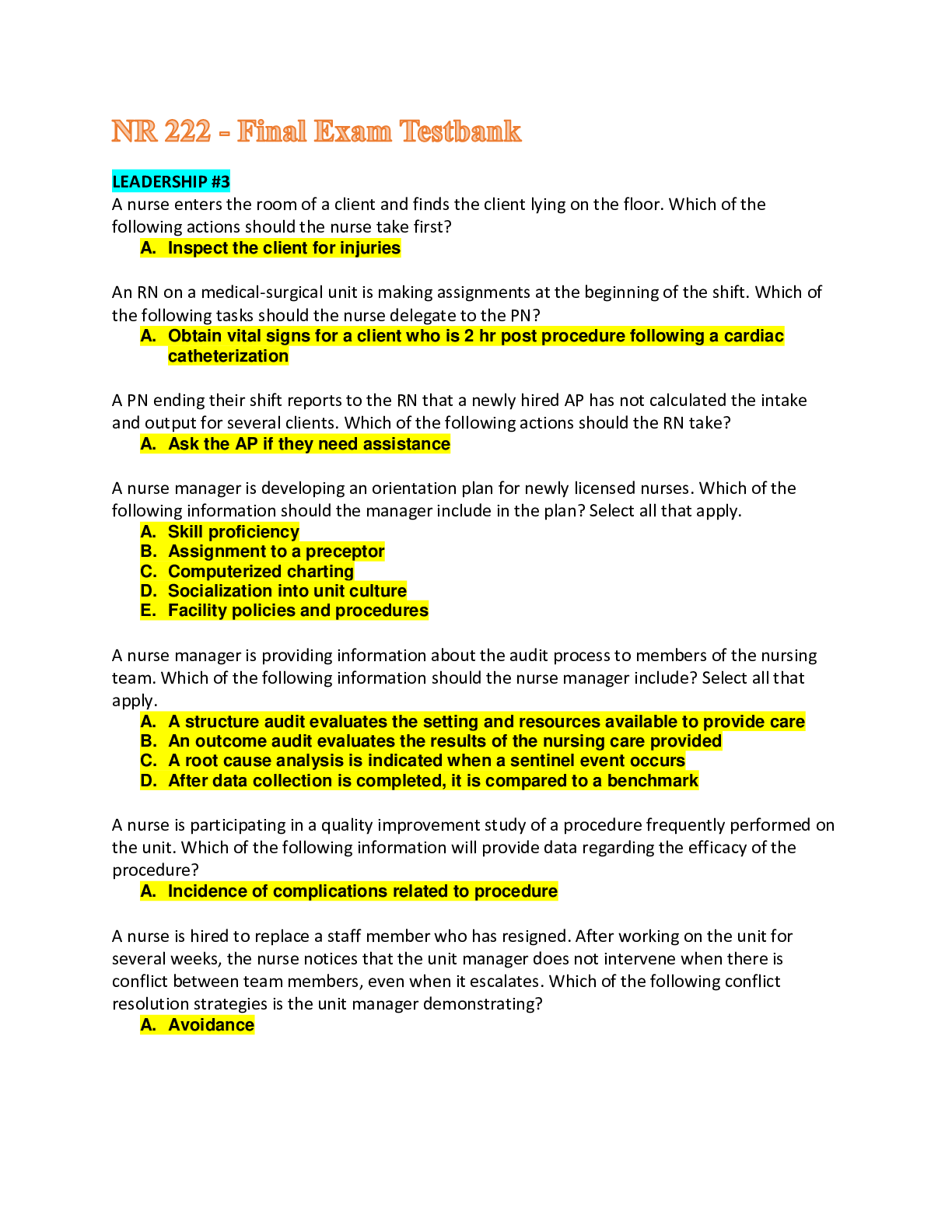
Reviews( 0 )
Document information
Connected school, study & course
About the document
Uploaded On
Dec 17, 2020
Number of pages
67
Written in
Additional information
This document has been written for:
Uploaded
Dec 17, 2020
Downloads
0
Views
168

.png)
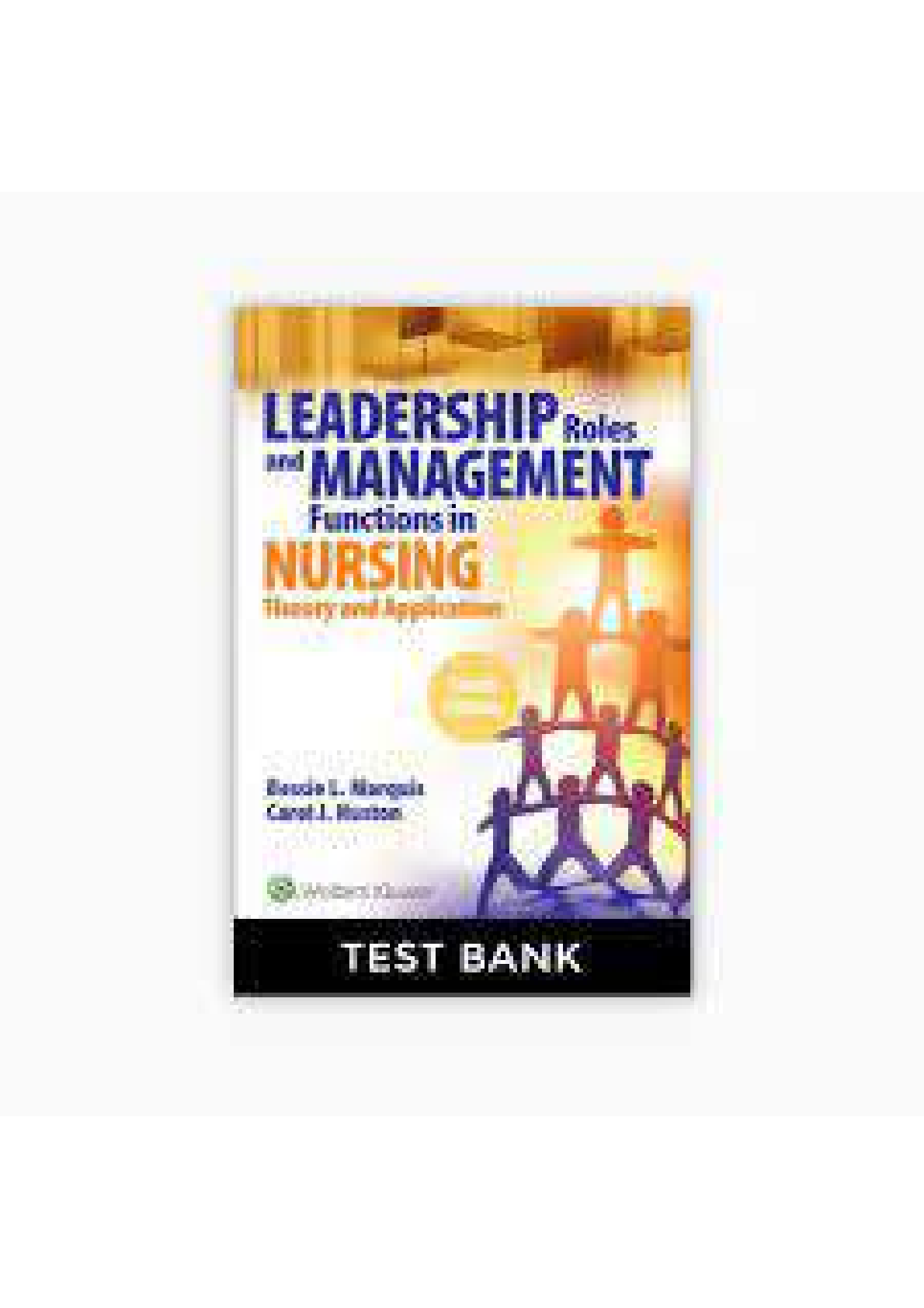
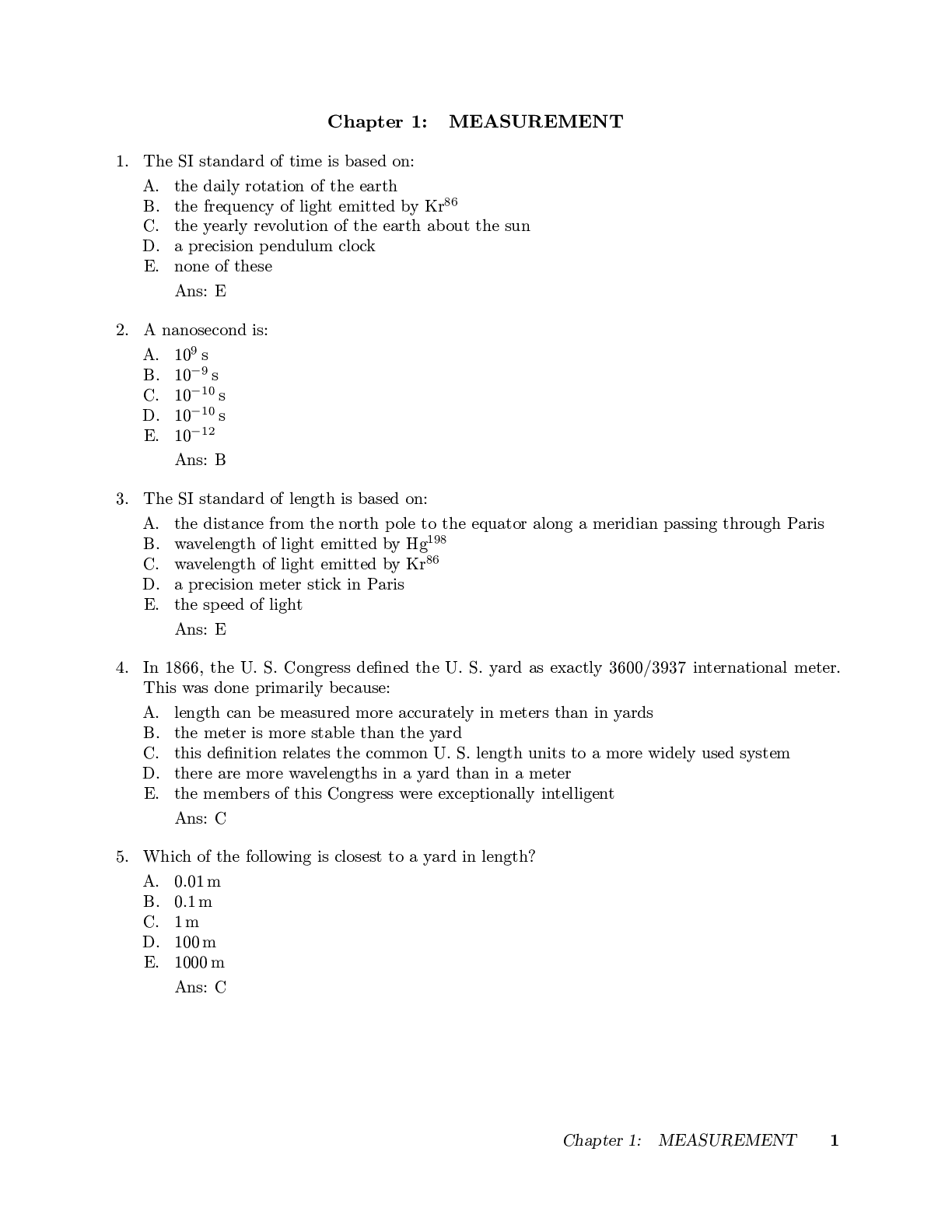
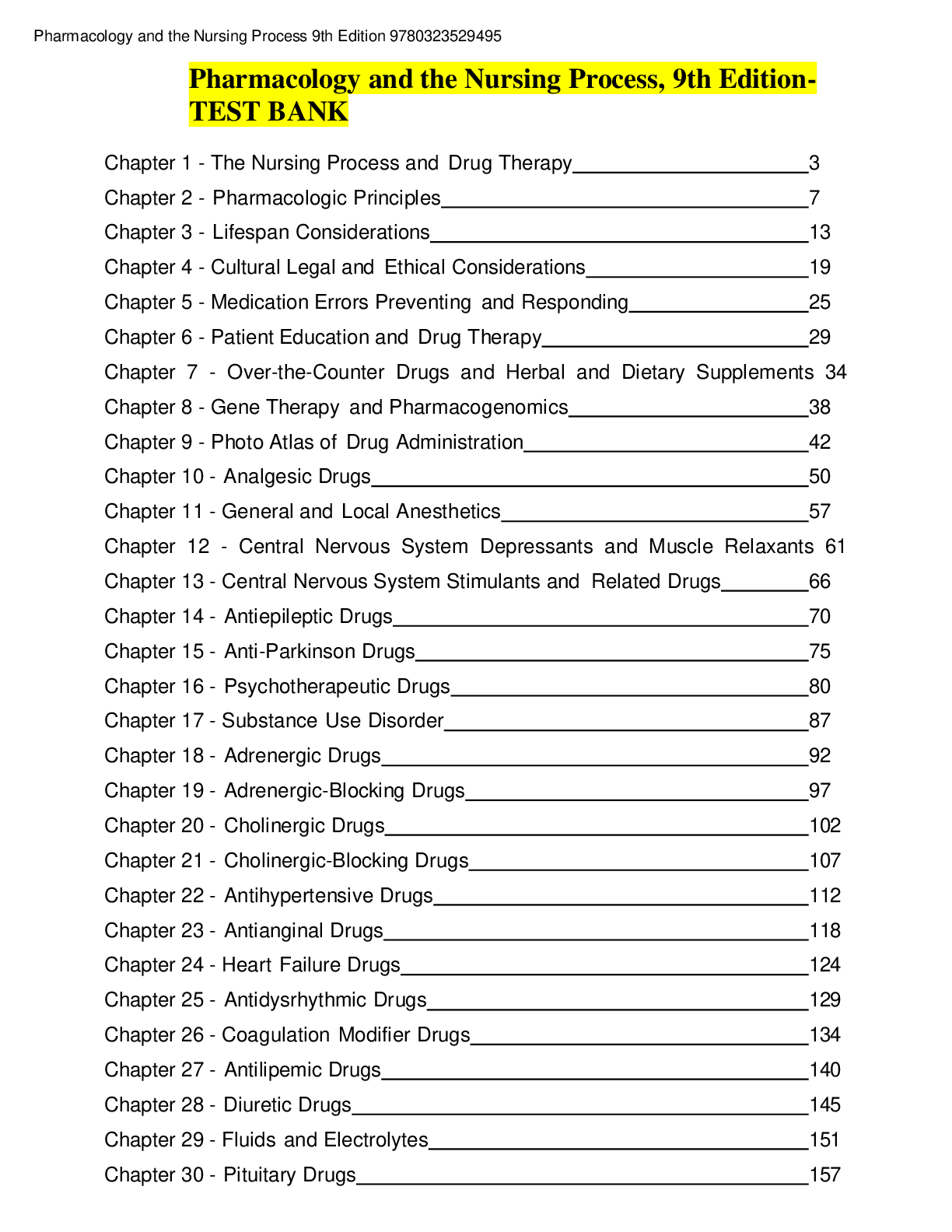


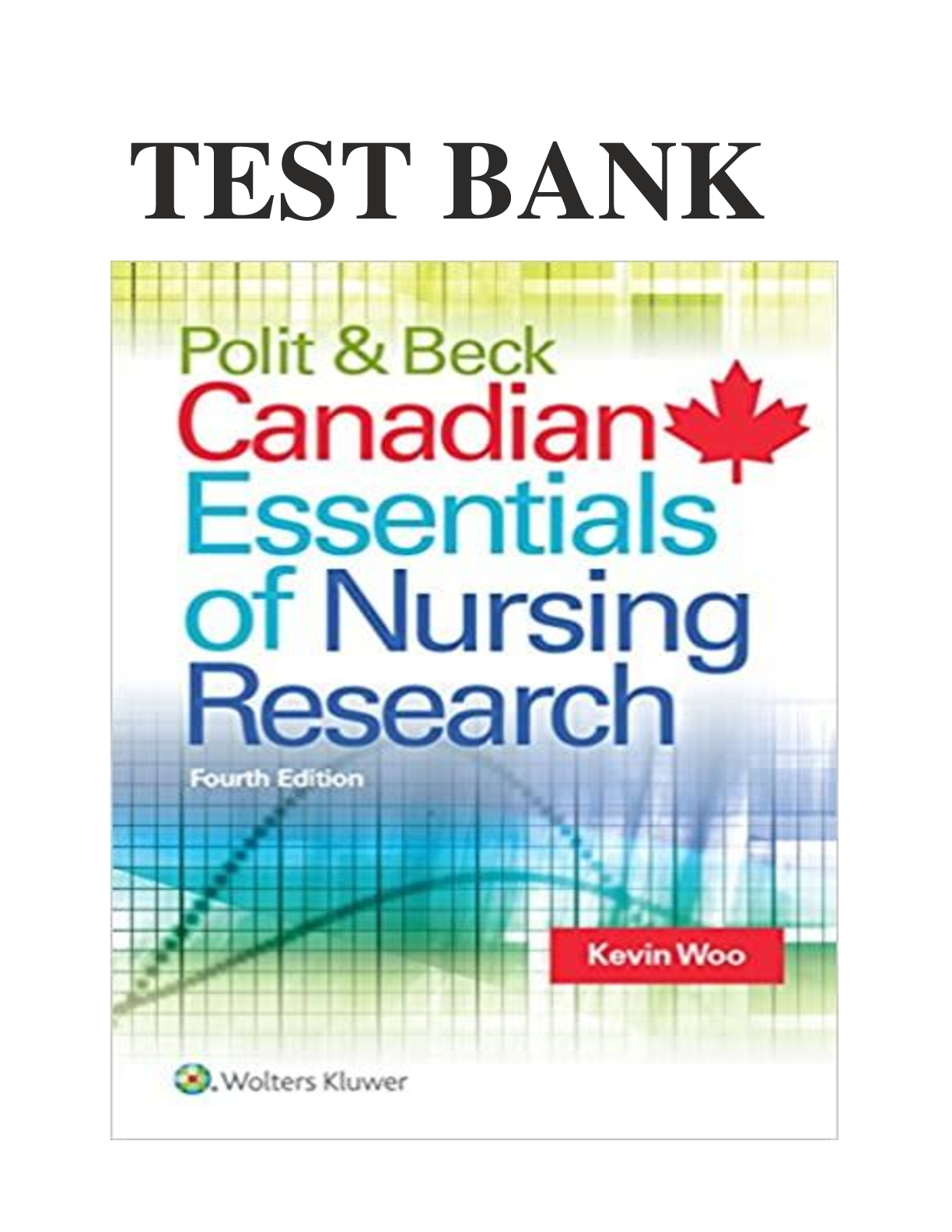
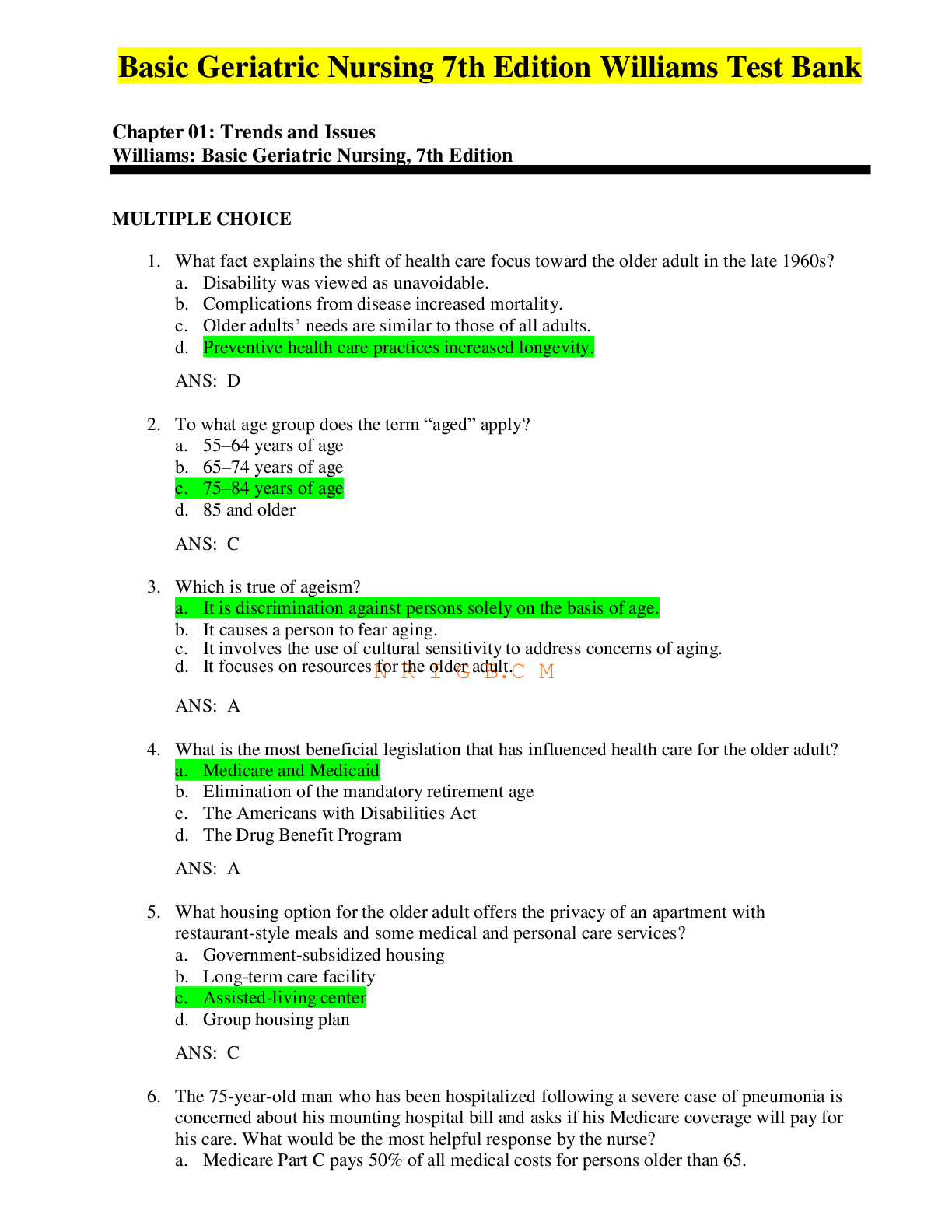
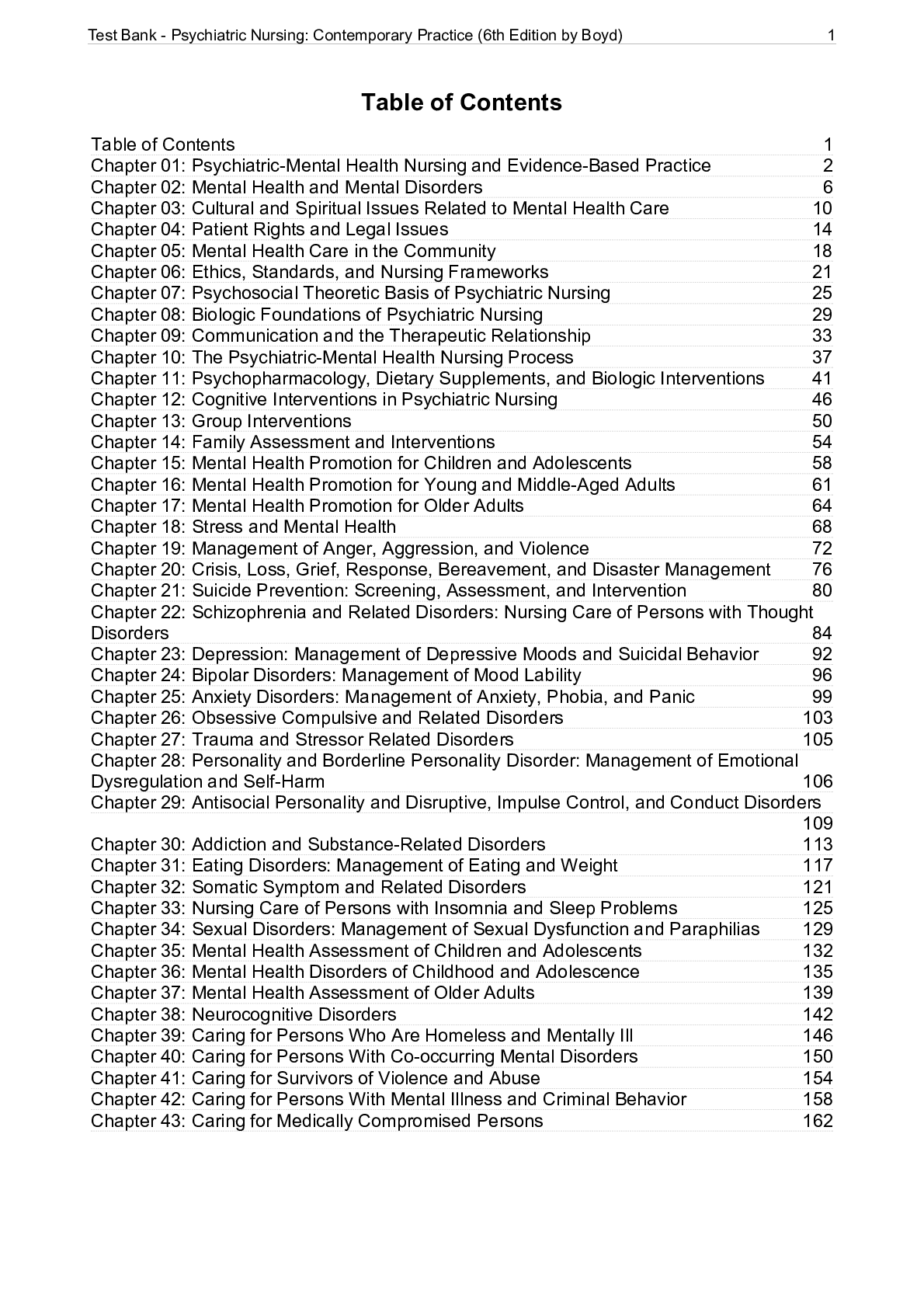
.png)
